Disclaimer
Jean Auguste Dominique Ingres
1780 - 1867
Self Portrait of Jean Auguste Dominique
Ingres
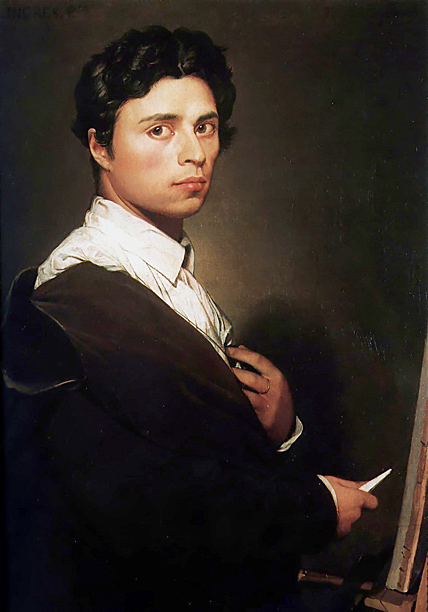
Jean Auguste Dominique Ingres (August 29, 1780 - January 14, 1867) was a French Neoclassical painter. Although he thought of himself as a painter of history in the tradition of Nicolas Poussin and Jacques-Louis David, by the end of his life it was his portraits, both painted and drawn, that were recognized as his greatest legacy.
A man profoundly respectful of the past, he assumed the role of a guardian of academic orthodoxy against the ascendant Romantic style represented by his nemesis Eugène Delacroix. His exemplars, as he once explained, were "the great masters which flourished in that century of glorious memory when Raphael set the eternal and incontestable bounds of the sublime in art ... I am thus a conservator of good doctrine, and not an innovator." Nevertheless modern opinion has tended to regard Ingres and the other Neoclassicists of his era as embodying the Romantic spirit of his time, while his expressive distortions of form and space make him an important precursor of modern art.
Napoleon I on His Imperial Throne
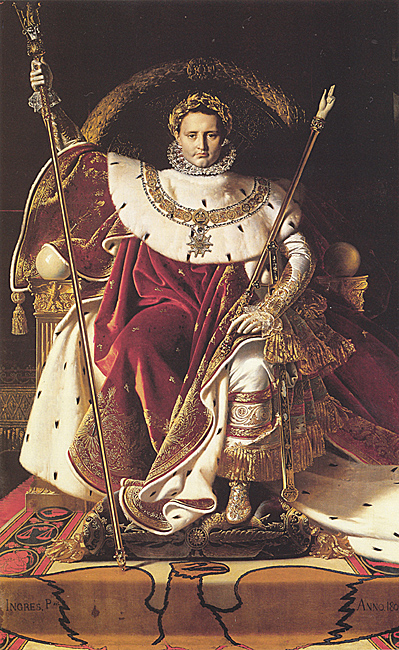
Napoleon I on His Imperial Throne (Detail)
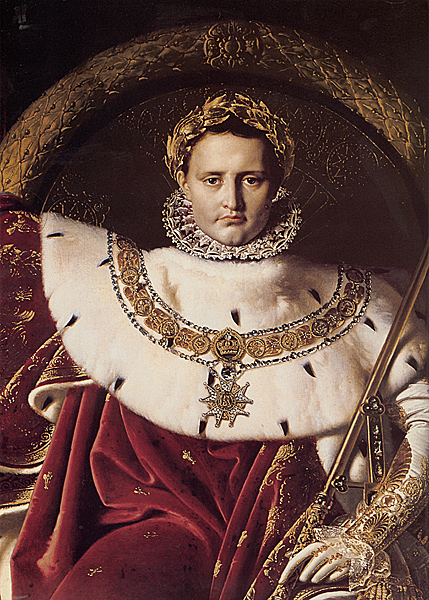
Ingres painted this portrait two years before Napoleon I was on His Imperial Throne. After Bonaparte and his wife, Josephine de Beauharnais, toured the northern departments of France in 1803, it was decided that portraits of the First Consul should be sent to five towns in the region to remind citizens of their loyalty to the new regime. Five artists-the young Ingres, Marie-Guilhemine Benoist, Jean-Baptiste Greuze, Robert Lefèvre, and Charles Meynier-ultimately received commissions from the minister of the interior to paint full-length portraits of Bonaparte. Ingres's painting, destined for Liège, in present-day Belgium, shows the First Consul pointing to an August 1803 decree that designated 300,000 francs for the reconstruction of that city, which had been partially destroyed by Austrian troops nine years earlier. As with the imperial portrait, it is unlikely that Bonaparte posed for Ingres.
Bonaparte as First Consul
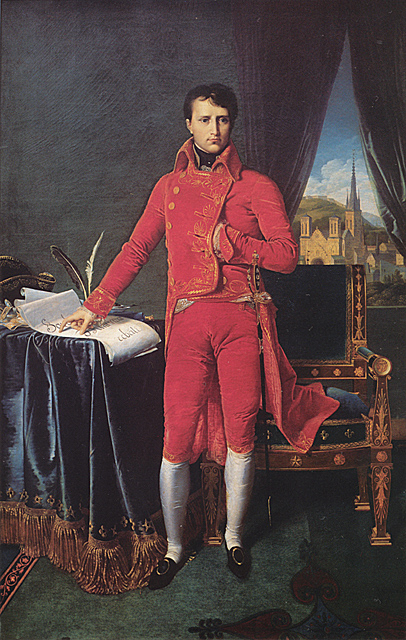
Antiochus and Stratonice
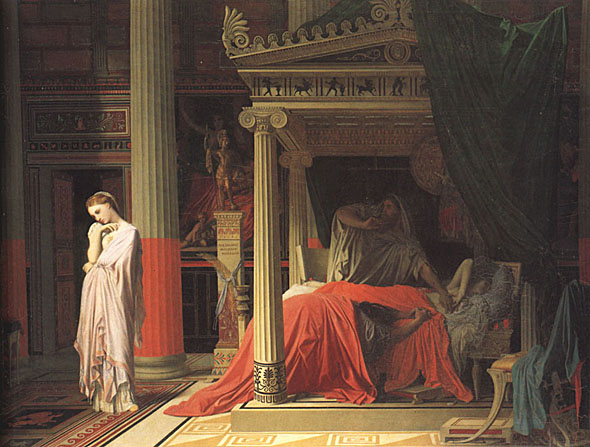
Comtesse Charles d'Agoult
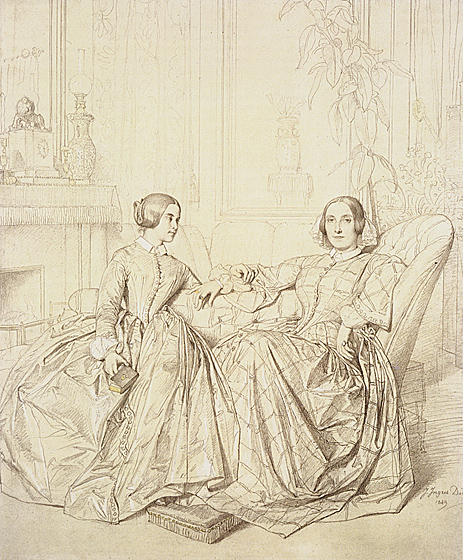
Marie Catherine Sophie de Flavigny, Vicomtesse de Flavigny (December 31, 1805 - March 5, 1876), was a French author, known also by her married name and title, Marie, Comtesse d'Agoult, and by her pen name, Daniel Stern.
She was born in Frankfurt-am-Main, Germany, the daughter of Alexander Victor François de Flavigny (1770-1819), a footloose emigré French aristocrat, and his wife Maria-Elisabeth Bethmann (1772-1847), a Jewish German banker's daughter whose family had converted to Catholicism. The young Marie spent her early years in Germany and completed her education in a French convent after the Bourbon Restoration. She entered into an early marriage of convenience with Charles Louis Constant d'Agoult, Comte d'Agoult (1790-1875) on May 16, 1827, thereby becoming the Comtesse d'Agoult. They had two daughters, Louise (1828-1834) and Claire (1830-1912). They were divorced on August 19, 1835.
From 1835 to 1839 she lived with virtuoso pianist and composer Franz Liszt, who was five years younger, and was a rising concert star. D'Agoult had three children with Liszt, but they did not marry, maintaining their independent views and other differences, while Liszt was busy composing and touring throughout Europe. Their children were Blandine (1835-1862), who was the first wife of Émile Ollivier but died at the age of 28; Cosima (1837-1930) (who married Richard Wagner, the second marriage for them both); and Daniel (1839-1859), who was already a promising pianist and gifted scholar when he died of tuberculosis at age 20. Chopin dedicated his second set of piano etudes to Marie d'Agoult.
She died in Paris, and was buried in Division 54 of Père Lachaise Cemetery.
Count Nikolai Dmitrievich Gouriev
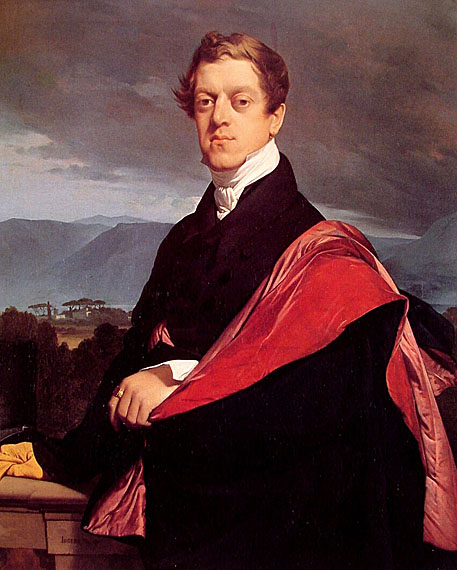
Ferdinand Philippe Louis Charles Henri Duc d'Orleans
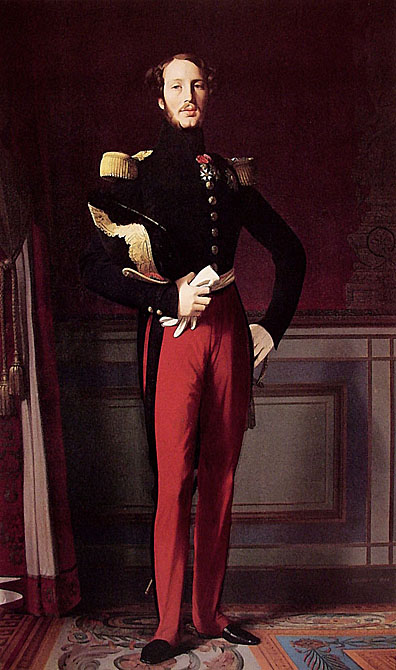
Francois Marius Granet
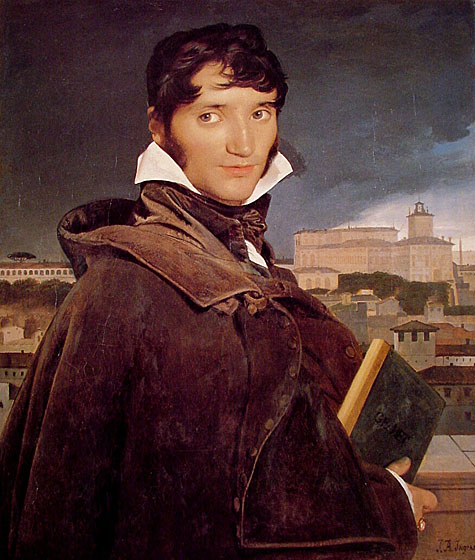
The boy's strong desires led his parents to place him--after some preliminary teaching from a passing Italian artist--in a free school of art directed by M. Constantin, a landscape painter of some reputation. In 1793, Granet followed the volunteers of Aix to the siege of Toulon, at the close of which he obtained employment as a decorator in the arsenal.
Whilst a lad he had, at Aix, made the acquaintance of the young comte de Forbin, and upon his invitation Granet, in the year 1797, went to Paris. De Forbin was one of the pupils of David, and Granet entered the same studio. Later he got possession of a cell in the convent of Capuchins, which, having served for a manufactory of assignats during the Revolution, was afterwards inhabited almost exclusively by artists. In the changing lights and shadows of the corridors of the Capuchins, Granet found the materials for that one picture to the painting of which, with varying success, he devoted his life.
In 1802 he left Paris for Rome, where he remained until 1819, when he returned to Paris, bringing with him besides various other works one of fourteen repetitions of his celebrated "Chevur des Capucins," executed in 1811. The figures of the monks celebrating mass are taken in this subject as a substantive part of the architectural effect, and this is the case with all Granet's works, even with those in which the figure subject would seem to assert its importance, and its historical or romantic interest. "Stella painting a Madonna on his Prison Wall," 1810 (Leuchtenberg collection); "Sodoma a l'hôpital," 1815 (Louvre); "Basilique basse de St François d'Assise," 1823 (Louvre); "Rachat de prisonniers," 1831 (Louvre); "Mort de Poussin," 1834 (Villa Demidoff, Florence), are among his principal works; all are marked by the same peculiarities, everything is sacrificed to tone.
In 1819 Louis Philippe decorated Granet, and afterwards named him Chevalier de l'Ordre St Michel, and Conservateur des tableaux de Versailles (1826). He became member of the institute in 1830; but in spite of these honours, and the ties which bound him to M. de Forbin, then director of the Louvre, Granet constantly returned to Rome. After 1848 he retired to Aix, immediately lost his wife, and died himself on the 21st of November 1849. He bequeathed to his native town the greater part of his fortune and all his collections, now exhibited in the house, together with a very fine portrait of the donor painted by Ingres in 1811.
General Louis Etienne Dulong de Rosnay
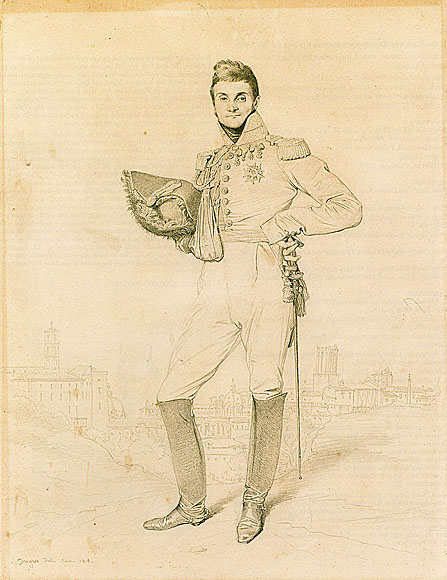
Hygin Edmond Ludovic Auguste Cave

Alexander Baillie
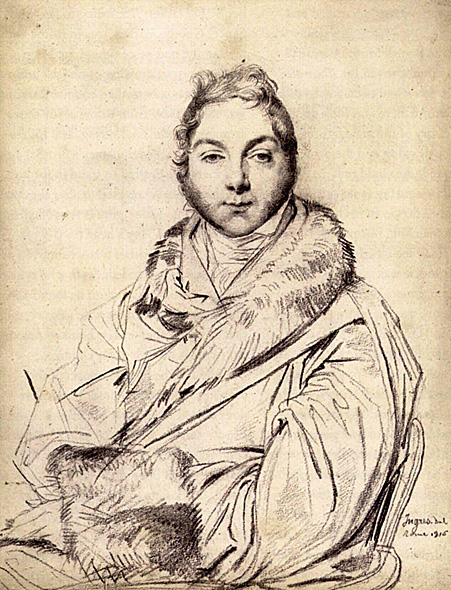
Alexis Rene Le Go

Amedee David Comte de Pastoret
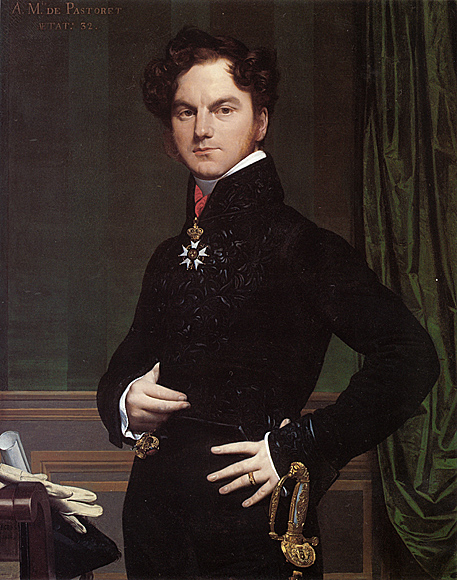
The Comte (later marquis) de Pastoret (1791-1857) first rose to prominence as a promising young bureaucrat during the Empire. His attachment to Napoleon did not prevent him from rallying to the Bourbons in 1814, however, and he was rewarded for this abrupt change of allegiance with a string of prestigious posts during the Restoration. In 1852, Pastoret was named a Senator by Napoleon III. It is not known when he and Ingres met-perhaps as early as 1809, in Rome-but they had a long professional and personal relationship, documented in their abundant correspondence. At the time of his death, Pastoret had collected no fewer than seven works by Ingres, and would have had more, if the painter had been able to fulfill all of his eager patron's requests.
Andre Benoit Barreau called Taurel
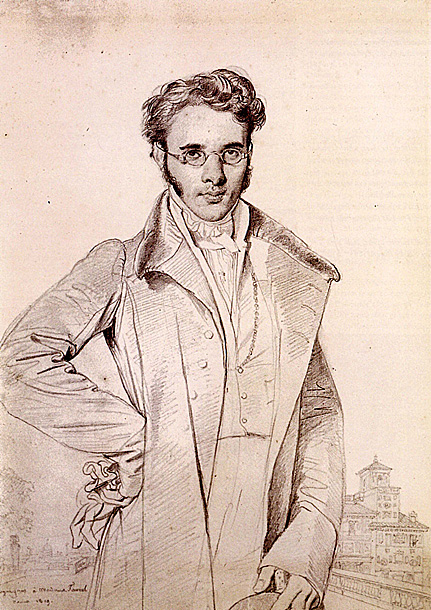
Angelique
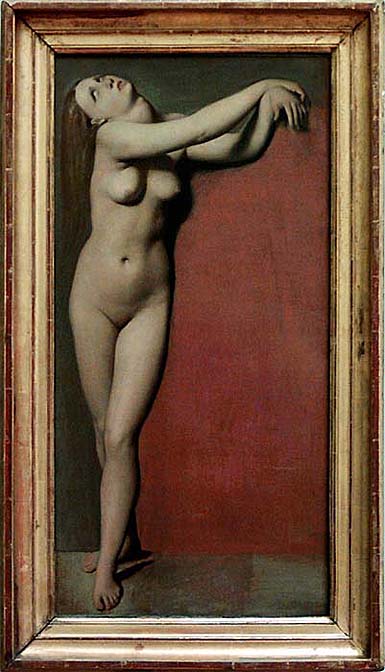
Antoine Thomeguex
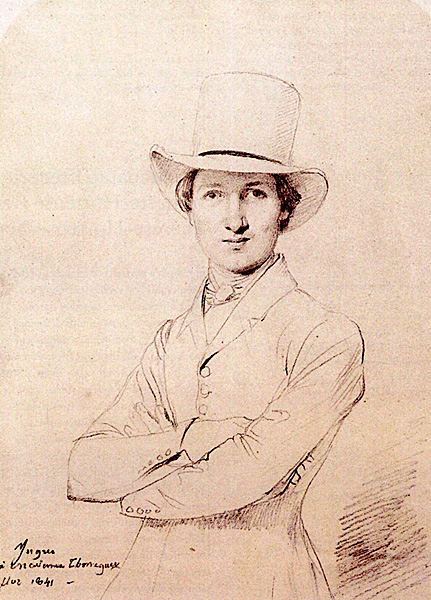
Auguste Jean Marie Guenepin: 1809
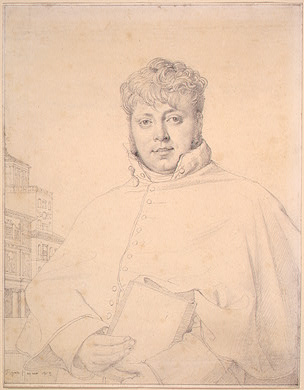
Baronne James de Rothschild
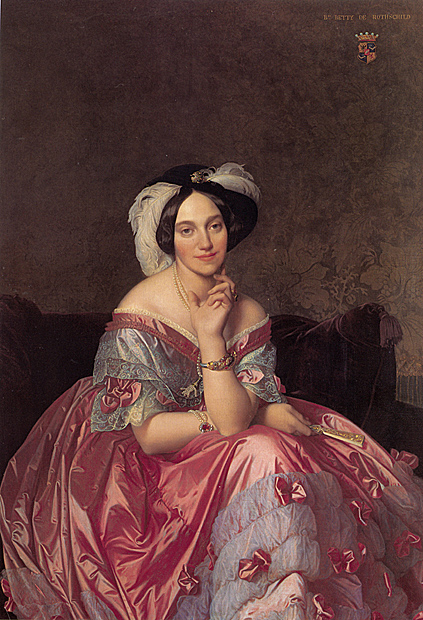
Charles Francois Mallet
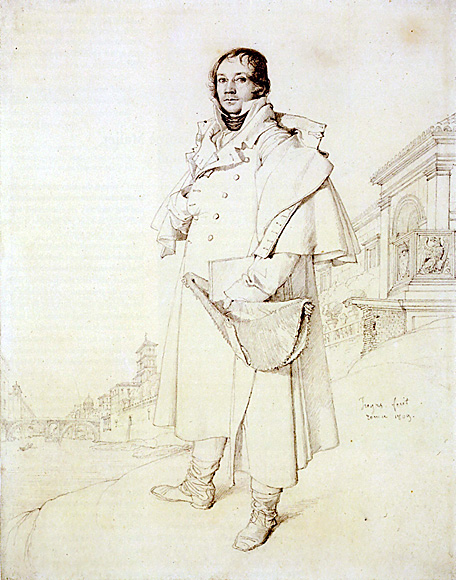
Charles Hayard and his daughter Marguerite
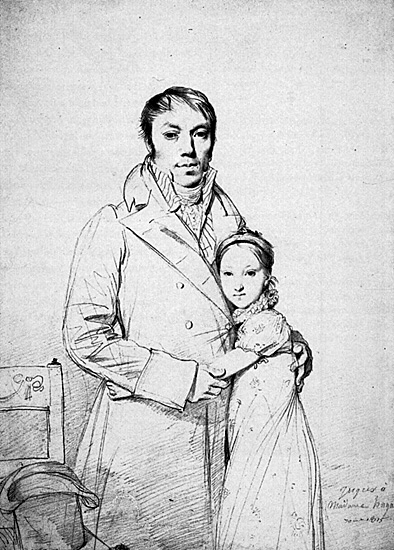
Charles Thomas Thruston
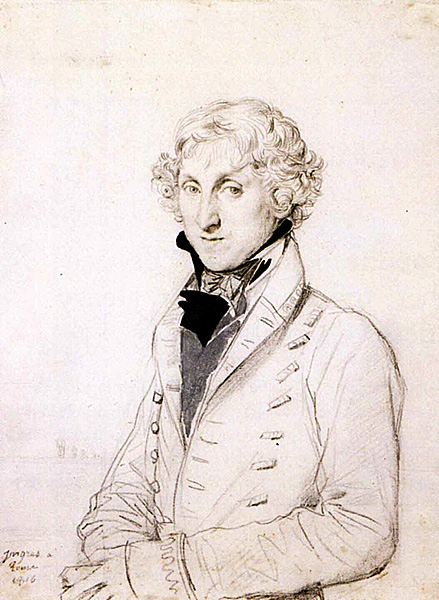
Comtess de Tournon
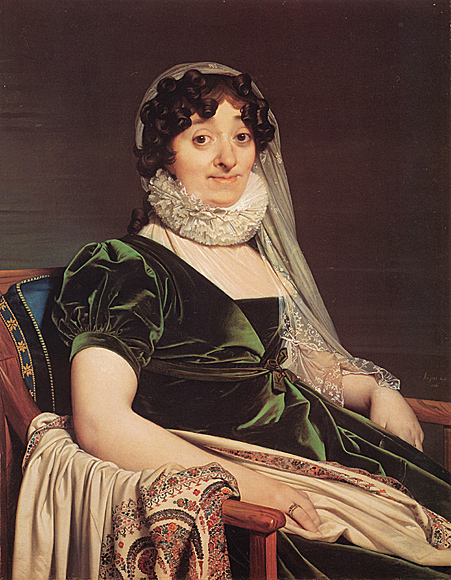
Self Portrait: 1804
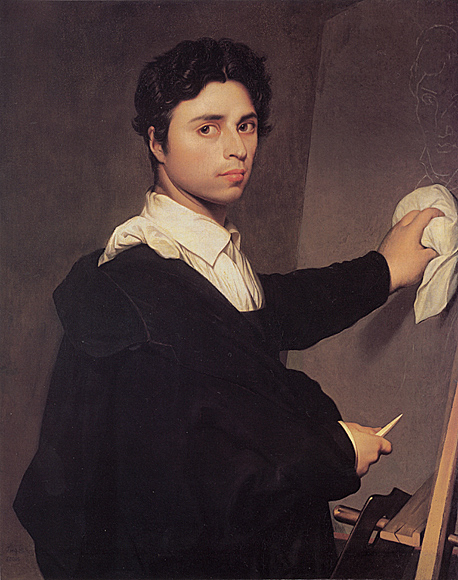
Madame Jean Auguste Dominique Ingres born Delphine Ramel
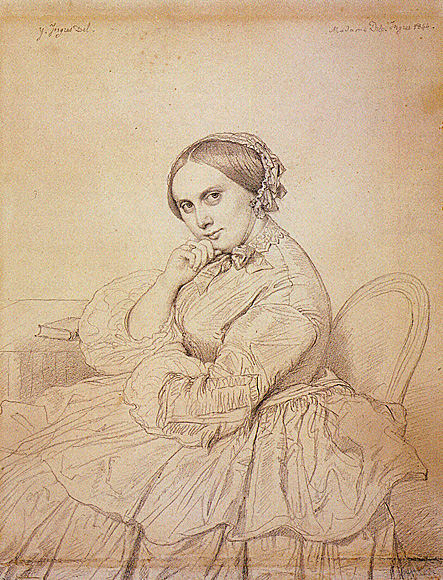
Delphine Ramel, Madame Ingres

At seventy-one years of age, Ingres married forty-three-year-old Delphine Ramel, a relative of his friend Marcotte d'Argenteuil. This marriage proved as happy as his first, and in the decade that followed Ingres completed several significant works.
Edmond Ramel and His Wife Born Irma Donbernard
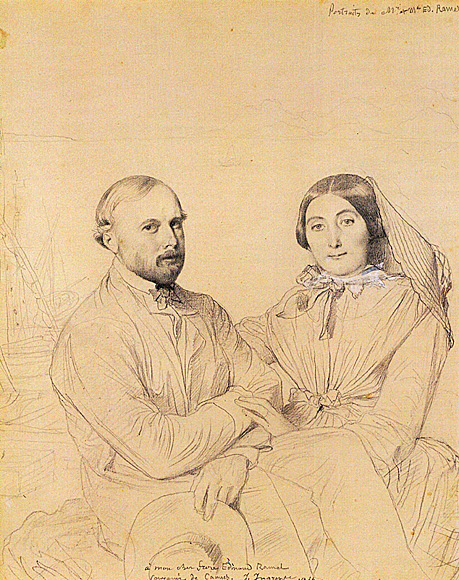
Dr. Francois Melier
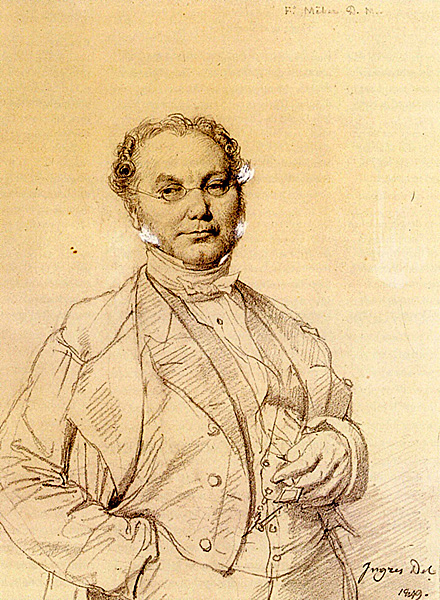
Dr. Jean Louis Robin
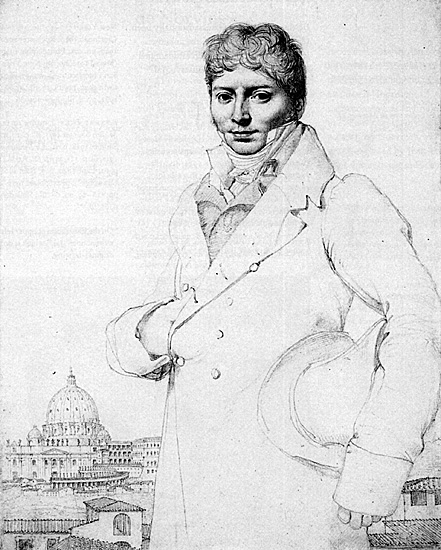
Dr. Louis Martinet
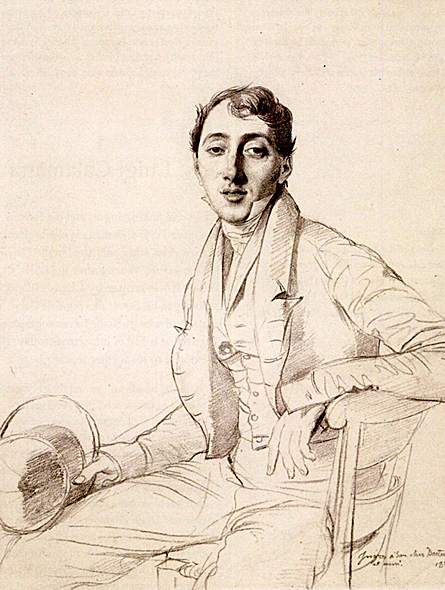
Dr. Louis Martinet -1826 (Detail)
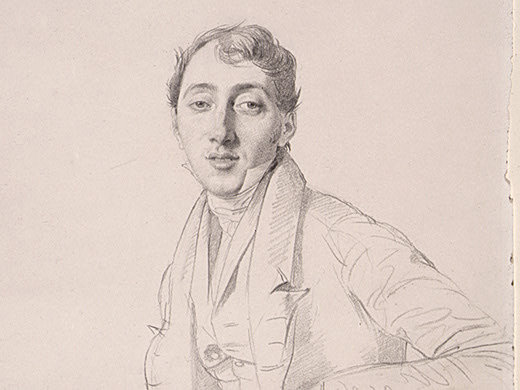
Dr. Thomas Church

Edme Francois Joseph Bochet
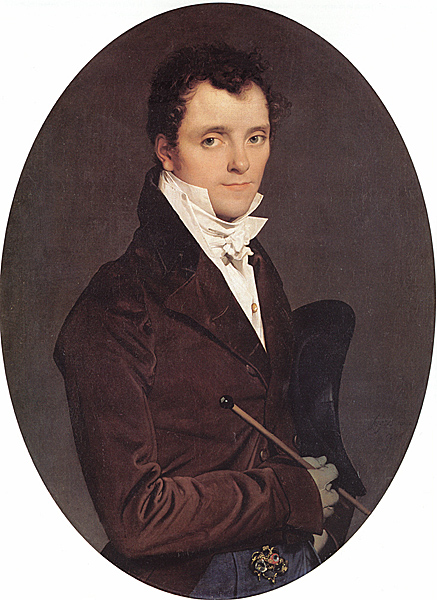
Felix Leblanc
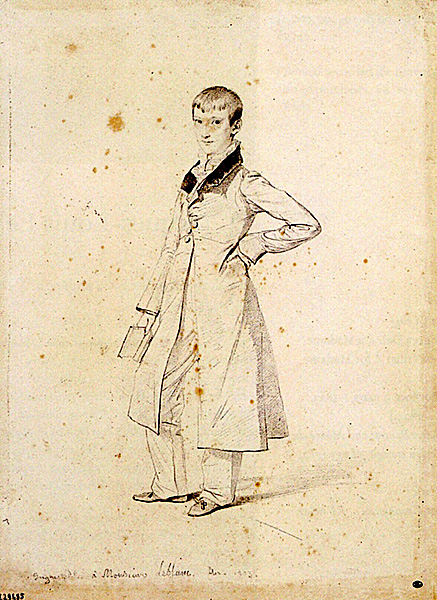
Franz Adolf von Stuerler
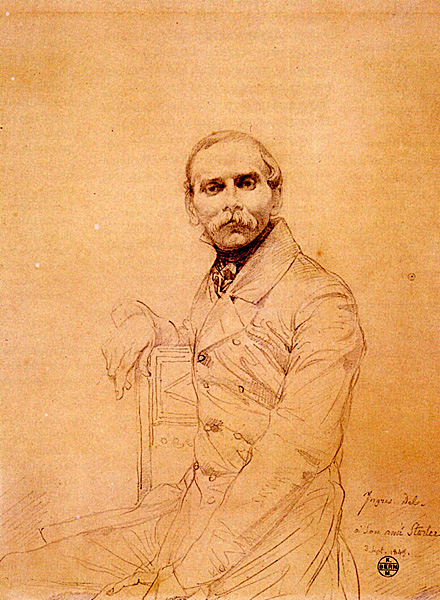
Franz Liszt

Franz Liszt (October 22, 1811 - July 31, 1886) was a Hungarian composer and virtuoso pianist of the 19th century. He was a renowned performer throughout Europe, noted especially for his showmanship and great skill with the piano. To this day, he is considered by some to have been the greatest pianist in history. As a composer, Liszt was one of the most prominent representatives of the "Neudeutsche Schule" ("New German School"). He left behind a huge oeuvre, including works from nearly all musical genres.
Guillaume Guillon Lethiere

Guillaume Guillon Lethière (1760-1832) was a French neoclassical painter.
Born in Guadalupe in 1760 to a French colonial official named Pierre Guillon and a disenfranchised "mulatto" mother, Lethière has been often written about in the context of French colonial history and the French Revolution.
At 14 years old, he moved from Guadalupe to France, and by 17 he had become the student of François Doyen at the Académie Royale de Peinture et de Sculpture. Lethière won second prize in the Prix de Rome of 1784 for his painting Woman of Canaan at the Feet of Christ. He entered again two years later, and while he did not win, he succeeding in receiving support to travel to Rome where he further developed his neoclassical style. Lethière remained in Rome for several years, and returned to Paris in 1791 to open a painting studio in direct competition with Jacques-Louis David. In 1818 Lethière was finally elected and also awarded the Légion d'honneur, and a year later he became a professor at the École des Beaux-Arts.
Half Figure of a Bather
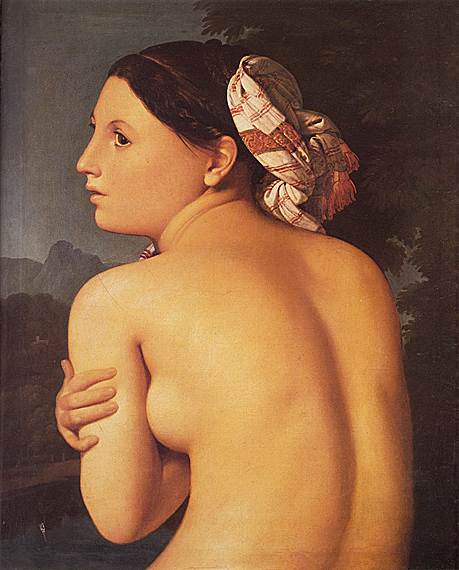
Henriette Harvey and Her Half Sister Elizabeth Norton
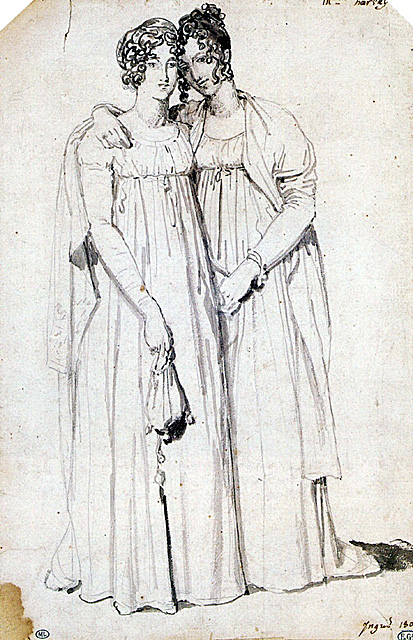
Hippolyte Francois Devillers
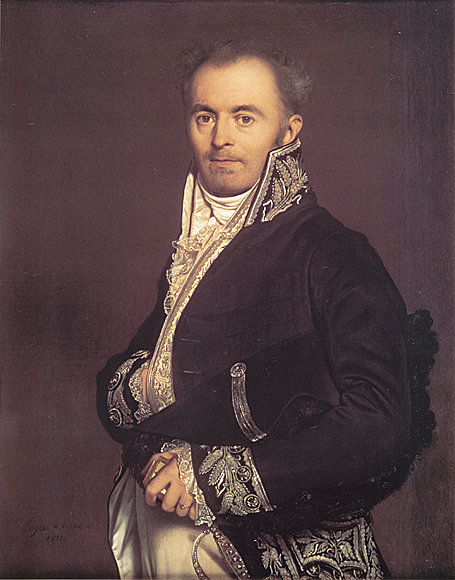
Jacques Marquet

It has been suggested that the bust depicted Napoleon I's son, the king of Rome, who was born in March 1811. After the Bourbons returned to power in 1814, such an imperial homage would have been detrimental to the ambitious artist, so Ingres may well have painted it out at that time.
Portrait of Mademoiselle Caroline Riviere
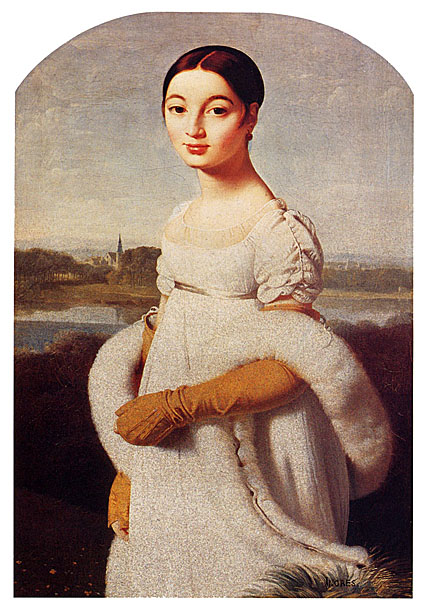
Mademoiselle Rivière was 15 when Ingres painted her. The portrait was shown at the Salon of 1806 along with his pictures of her parents and Napoleon. By the end of the year she was dead.
The Grande Odalisque
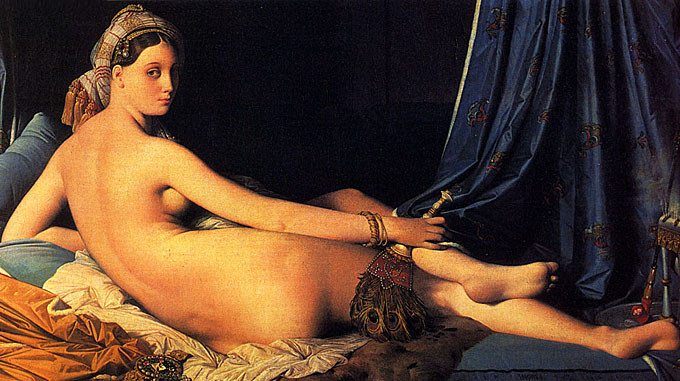
Commissioned by Caroline Murat, the Queen of Naples and sister of Napoleon Bonaparte, La Grande Odalisque was intended to accompany another Ingres' nude which she owned: Sleeping Woman, Nude. An Odalisque was a female, usually a slave, from a Turkish harem and Ingres painted several works on the subject, although La Grande... is by far his most famous; it now hangs in the Louvre. Several reports maintain that Caroline was the model for the Odalisque but, while she may have been an inspiration, it's unlikely to have been her.
Jean Baptiste Desdeban
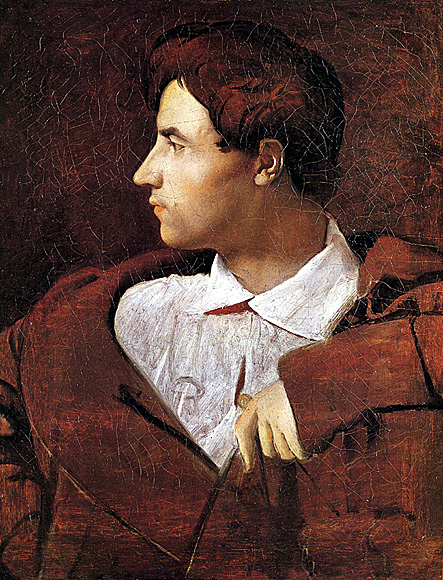
Jean Charles Auguste Simon
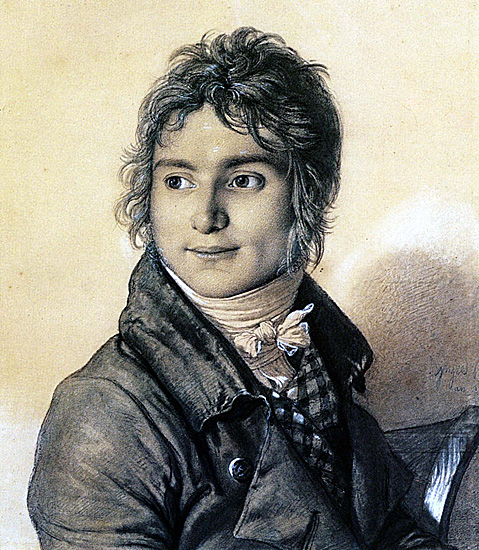
Jean Francois Antoine Forest
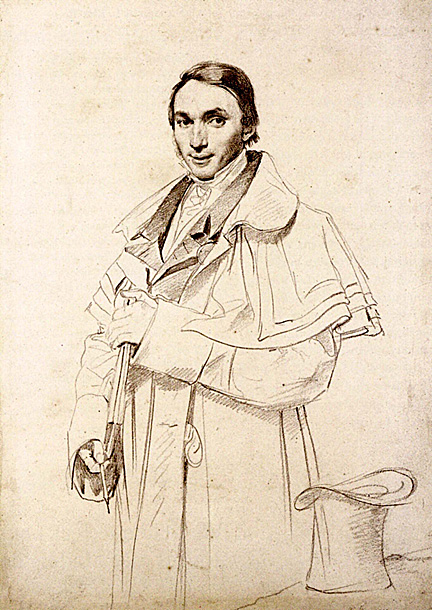
Jean Francois Julien Menager
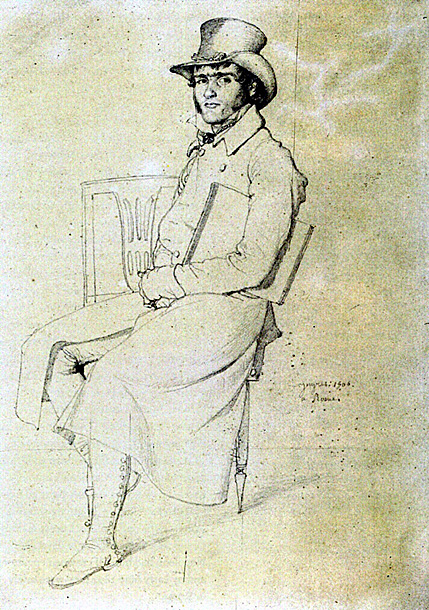
Jean Marie Joseph Ingres
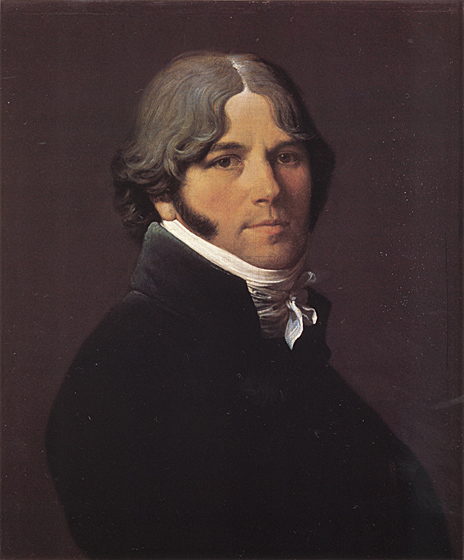
Jean Pierre Cortot
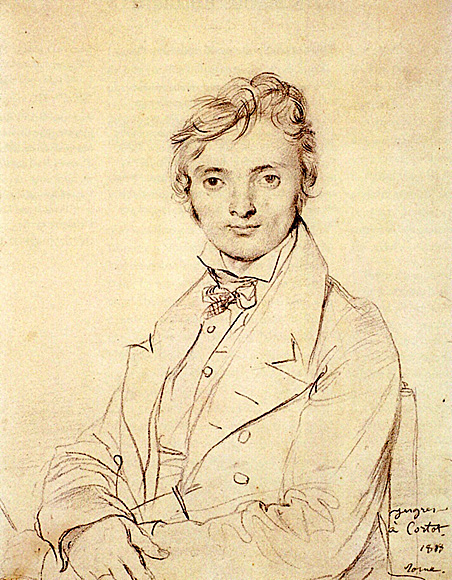
Jacques Marquet Baron de Montbreton de Norvins
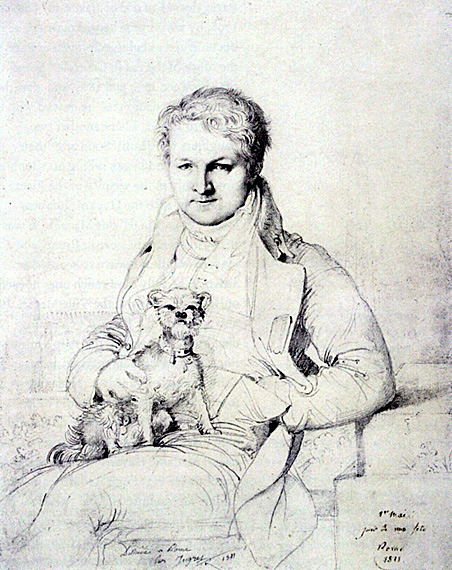
John Russel Sixth Duke of Bedford
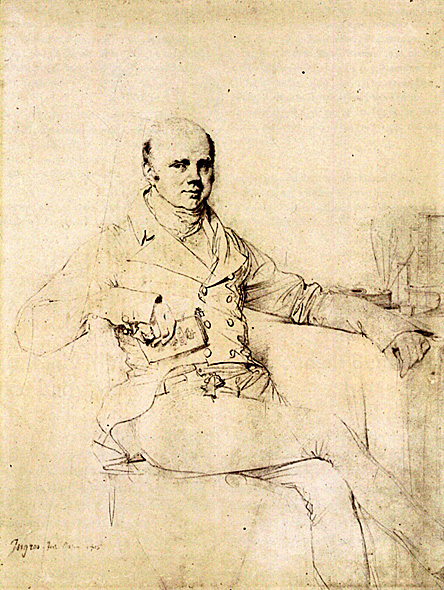
John Russell, 6th Duke of Bedford (6 July 1766 - 20 October 1839) was a younger son of Francis Russell, Marquess of Tavistock (eldest son and heir of the 4th Duke of Bedford who had died during the lifetime of his father) and Lady Elizabeth Keppel (the youngest child of Willem van Keppel, 2nd Earl of Albemarle and Lady Anne Lennox). At the time of his birth, Lord John Russell (as he then was) was not expected to succeed to the title - unless his elder brother, Francis Russell, Lord Howland died in infancy or at some point later without legitimate heirs.
Lord John Russell married relatively young, to Georgiana Byng, a daughter of the 4th Viscount Torrington. They had three sons before she died young:
Francis Russell, 7th Duke of Bedford
Lord George William Russell
Lord John Russell, who served as Prime Minister of the United Kingdom and became the 1st Earl Russell, and was the ancestor of philosopher Bertrand Russell.
Joseph Antoine Moltedo
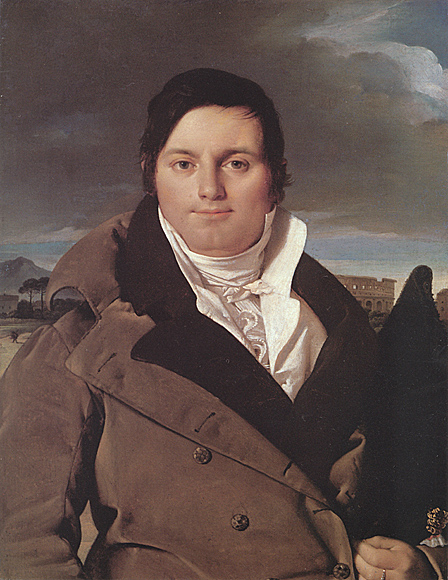
Moltedo (b. 1775) was typical of Ingres's portrait clientele in Rome: a senior civil servant of the Empire and a successful businessman. Moltedo, who was from Corsica, owned a lead mine in Tivoli and a fur-trading business and directed both an import-export concern and a bank. He also served as treasurer of the army and as inspector and director of the mail in Rome.
Joseph Woodhead and His Eife Born Harriet Comber and
Her Brother Henry George Wandesford Comber
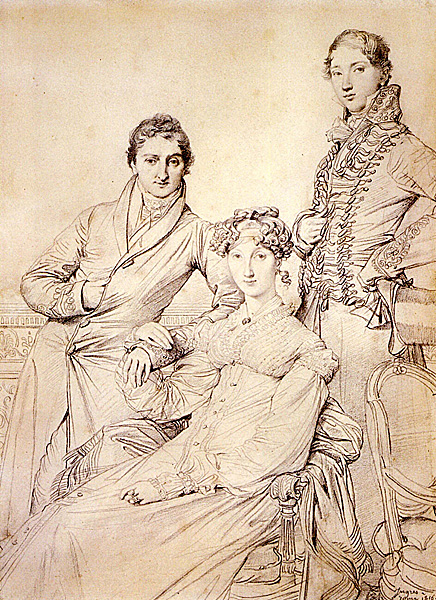
Jupiter and Thetis
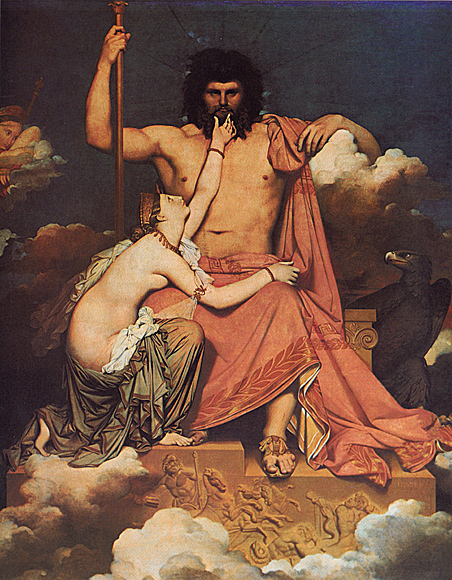
Thetis found Zeus,
wide-seeing son of Cronos, some distance from the rest,
seated on the highest peak of many-ridged Olympus.
She sat down right in front of him. With her left hand,
she clutched his knees, with her right she cupped his chin,
in supplication to lord Zeus, son of Cronos:
"Father Zeus, if, among the deathless gods,
I've ever served you well in word or deed,
then grant my prayer will be fulfilled.
Bring honour to my son, who, of all men
will be fate's quickest victim. For just now,
Agamemnon, king of men, has shamed him.
He seized his prize, robbing him in person,
and kept it for himself. But honour him,
Zeus, all-wise Olympian. Give the Trojans
the upper hand, until Achaeans respect my son,
until they multiply his honours."
Thetis finished. Cloud gatherer Zeus did not respond.
He sat a long time silent. Thetis held his knees,
clinging close, repeating her request once more
Homer, Iliad Book 1
La Source

Lady William Henry Cavendish Bentinck born Lady Mary Acheson
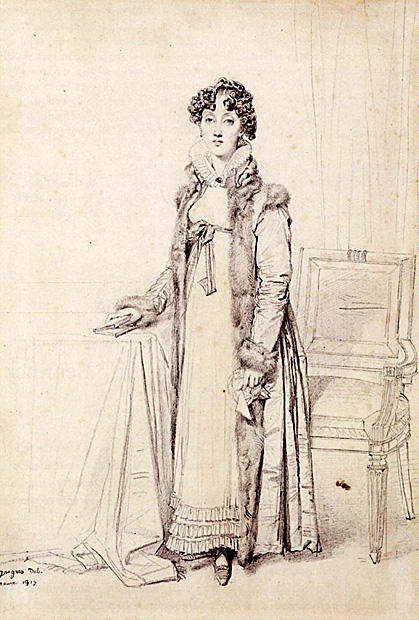
Lady William Henry Cavendish
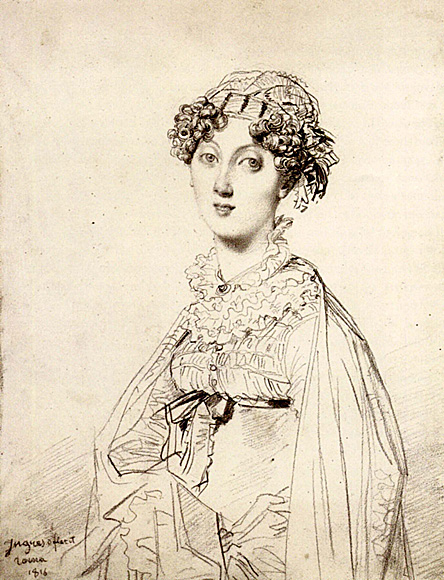
Lord Granham Thomas Philip Robinson

Lorenzo Bartolini
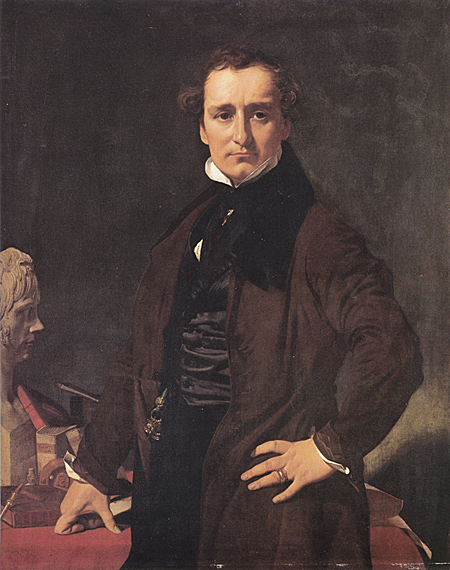
Lorenzo Bartolini (7 January 1777 - 20 January 1850) was an Italian sculptor who infused his neoclassicism with a strain of sentimental piety and naturalistic detail, while he drew inspiration from the sculpture of the Florentine Renaissance rather than the overpowering influence of Antonio Canova that circumscribed his Florentine contemporaries.
Louis Francois Bertin
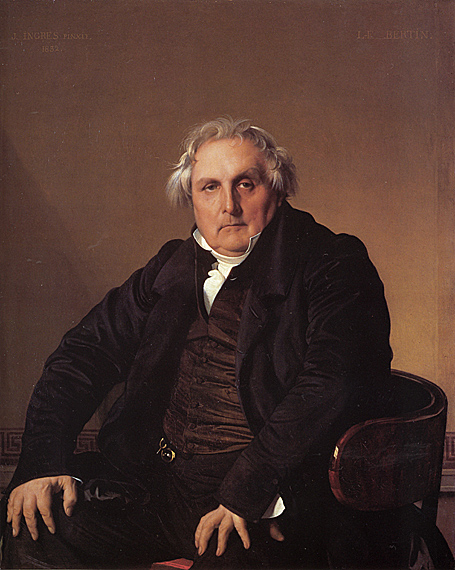
Born in Paris (his father was a former secretary of Étienne François, duc de Choiseul), and considered in retrospect the most import member of the Bertin family, he began his journalistic career by writing for the Journal Français and other papers during the French Revolution. After the Napoleon Bonaparte's 18 Brumaire Coup he founded the conservative paper with which the name of his family has chiefly been connected, the Journal des Débats. Guided by the contributions of figures such as Joseph Fiévée, Julien Louis Geoffroy, Jean François Joseph Dussault, François-René de Chateaubriand, Charles-Marie-Dorimond de Féletz, Jean François Boissonade de Fontarabie, Conrad Malte-Brun, François Benoît Hoffmann, and Charles Nodier, the Journal soon became a major authority in French press and literature. Bertin is credited with the invention of the feuilleton, a supplement to the political section of a newspaper, usually in smaller type, which carried gossip, fashion, criticism, epigrams and charades, and which fostered a culture of literary gamesmanship.
Suspected of royalist tendencies by the French Consulate, he was imprisoned at the Temple in 1800, and exiled in 1801. Bertin returned to Paris in 1805, after the proclamation of the Empire, and resumed the management of the paper, the title of which had been changed by order of Napoleon to that of Journal de l'Empire. He had to submit to a rigorous censorship, and in 1811 the conduct, together with the profits, was taken over entirely by the government.
In 1814 he regained possession, restored the old title, and continued his support of the royalist cause during the Hundred Days, joining Louis XVIII in the Southern Netherlands, where he edited the Moniteur Universel as Moniteur de Gand.
Back with the full Bourbon Restoration, Bertin directed the Moniteur until 1823, when the Journal des Débats became the recognized organ of the liberal-constitutional opposition after he had come to criticize absolutism (a road similar to the one taken by François-René de Chateaubriand). Bertin's support was, however, given to the July Monarchy after 1830. He died in Paris, 1841.
Jean Auguste Dominique Ingres' portrait of Bertin (1832), first exhibited at the 1833 Paris Salon, is today one of the most famous works by the painter.
Lucien Bonaparte
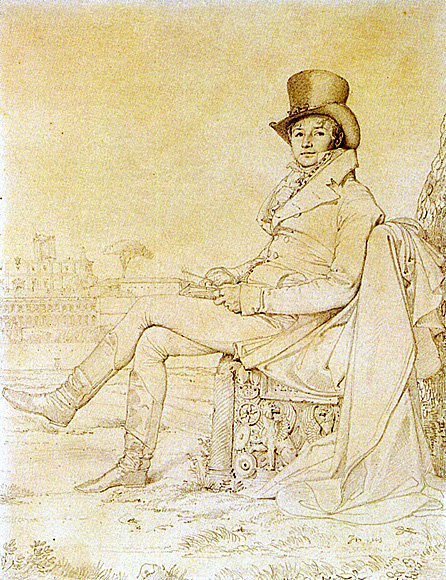
Lucien Bonaparte, Prince Français, 1st Principe di Canino and 1st Principe di Musignano (born Luciano Buonaparte; (May 21, 1775 - June 29, 1840) was the third surviving son of Carlo Buonaparte and his wife Letizia Ramolino.
Lucien was a younger brother of Joseph and Napoleon Bonaparte, and an older brother of Elisa, Louis, Pauline, Caroline and Jérôme Bonaparte. Lucien held genuinely revolutionary views, which led to an often abrasive relationship with his brother Napoleon, who seized control of the French government in 1799, when Lucien was 24.
Luigi Calamatta
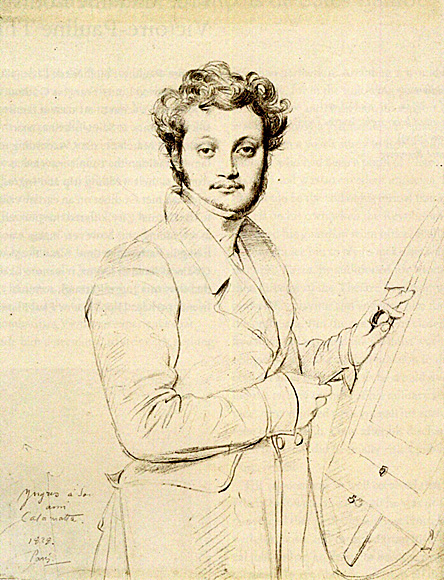
Luigi Calamatta (1801 - February 1868) was an Italian painter and engraver. He was born at Civitavecchia. Orphaned early, he went to live with an uncle, then move to Rome to live in the l'Ospizio San Michele. He was expelled from the hospice, and became the ward of fellow artists.
He studied drawing at Rome under Giangiacomo, took his early lessons in engraving from Marchetti. and executed his first plate under the eye of Ricciari. He went to Paris in 1822, and became a follower of Ingres, whose style he copied in his engraving of The Vow of Louis XIII. He made his first appearance at the Salon of 1827, with an engraving of Bajazet and the Shepherd, after Pierre Joseph Dedreux-Dorcy. He next produced the Mask of Napoleon, from the cast taken by Dr. Antommarchi at St. Helena in 1814, grouping around it a symbolic gathering, embracing portraits, chiefly from Ingres' drawings, of Madame Dudevant, Paganini, Martin, and Duclos. He visited Florence in 1836, and the following year saw him installed as professor of engraving at Brussels. He was later appointed by Giuseppe Longhi to a similar post at the Brera in Milan, und where he died in 1869. His wife was also an artist, and produced an excellent portrait of her father, the archeologist Raoul Rochette, as well as The Virgin (1842), Eudora and Cymadaceus (1844),St. Cecilia (1846),Eve (1848), St. Veronica (1851).
Madame Alexandre Lethiere born Rosa Meli and Her Daughter Letizia
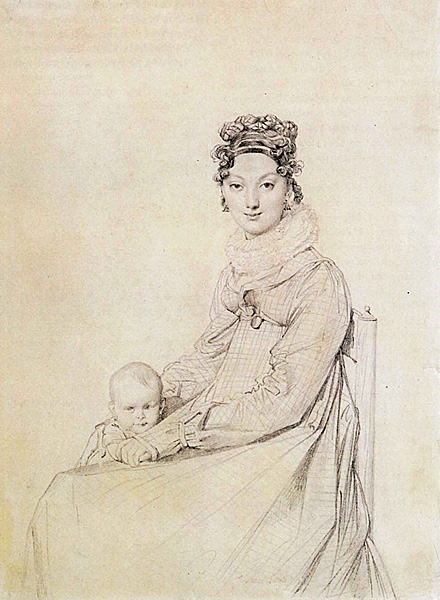
Madame Aymon

Madame Charles Gounod born Anna Zimmermannn
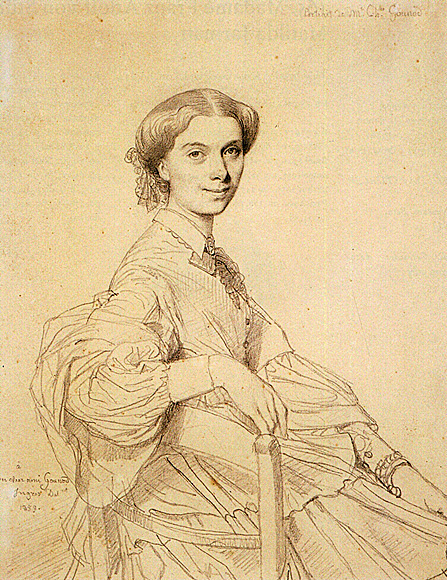
Madame Charles Hayard born Jeanne Susanne
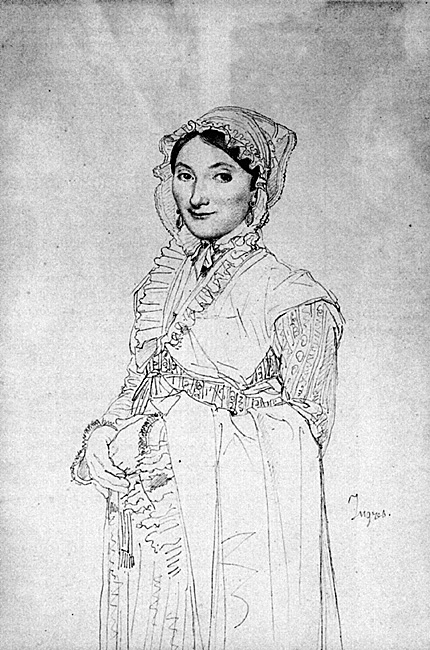
Madame Charles Simart born Amelie Baltard
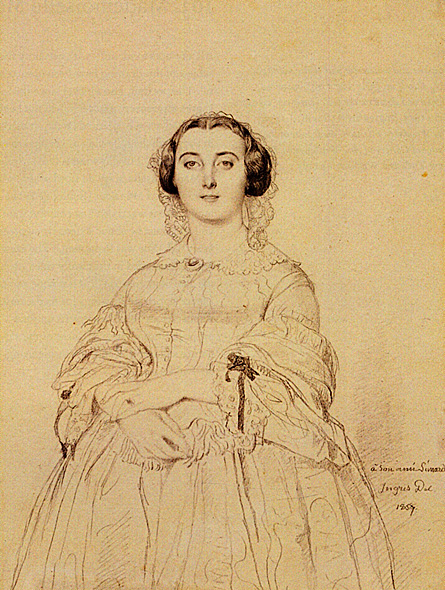
Madame Jean Auguste Dominique Ingres born Madeleine Chapelle

Madame Jean Auguste Dominique Ingres born Madeleine Chapelle
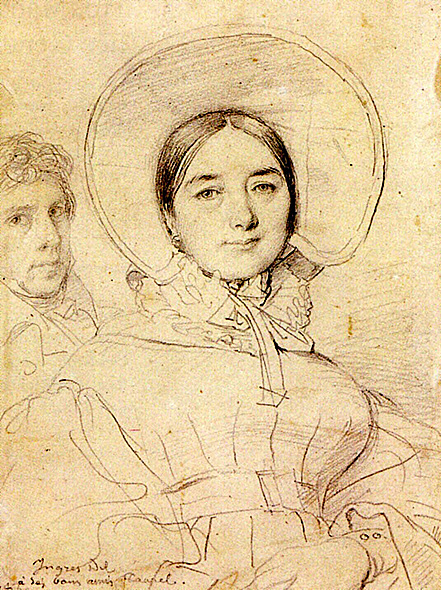
Madame Jean Auguste Dominique Ingres born Madeleine Chapelle

Madame Jean Auguste Dominique Ingres born Madeleine Chapelle
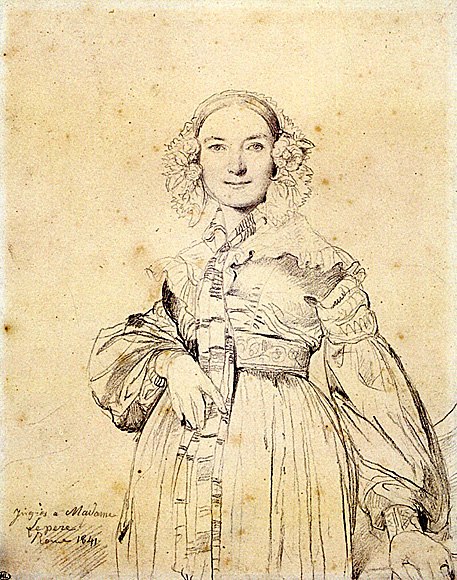
Madame de Senonnes
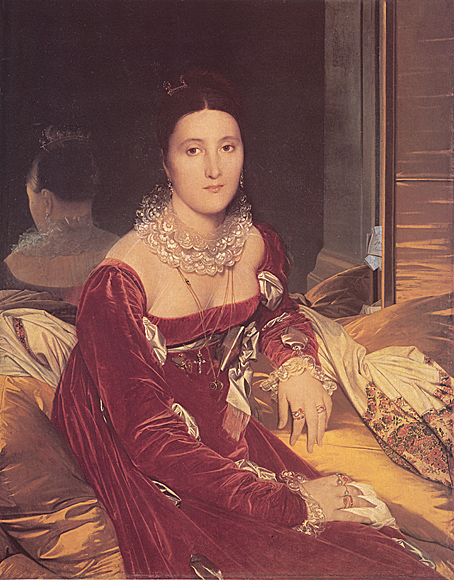
After marrying Madeleine Chapelle in December 1813, Ingres continued to paint portraits of wealthy sitters in order to support his new wife. This painting depicts a thirty-one-year-old divorcée, the beautiful mistress of Alexandre de la Motte-Baracée, vicomte de Senonnes, a wealthy collector and amateur artist living in Rome. Marcoz (1783-1828), a native of Lyons, had married a Frenchman whose textile business brought the couple to Rome. They divorced in 1809, and within months, she had established herself as Senonnes's mistress. The viscount married Marcoz less than a year after this portrait was painted, much to the dismay of his family.
Madame Duvaucey
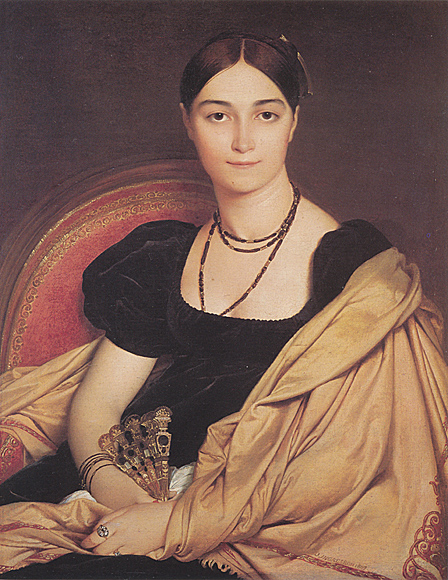
Madame Felix Gallois born Nathalie Rose Joachime Bochet
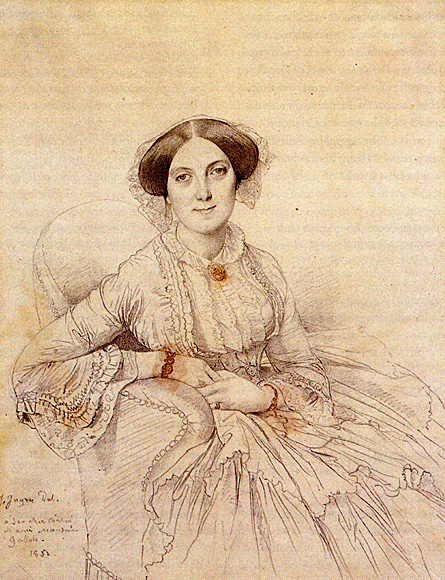
Madame Franz Adolf von Stuerler born Matilda Jarman
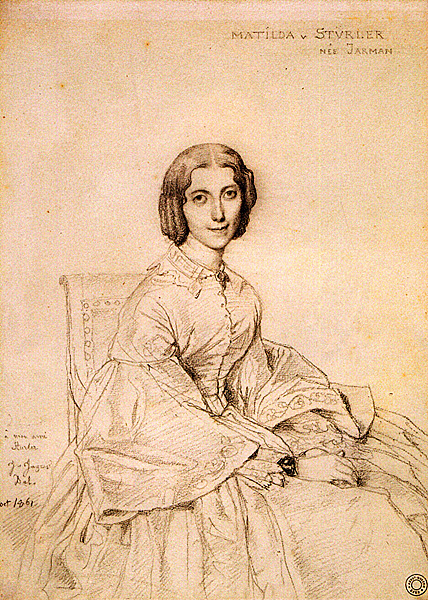
Madame Frederic Reiset born Augustine Modeste Hortense Reiset and
Her Daughter Therese Hortense Marie
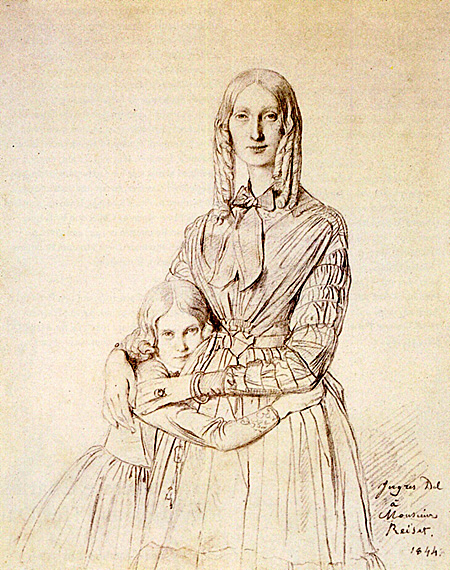
Madame Guillame Mallet born Anne Julie Houel
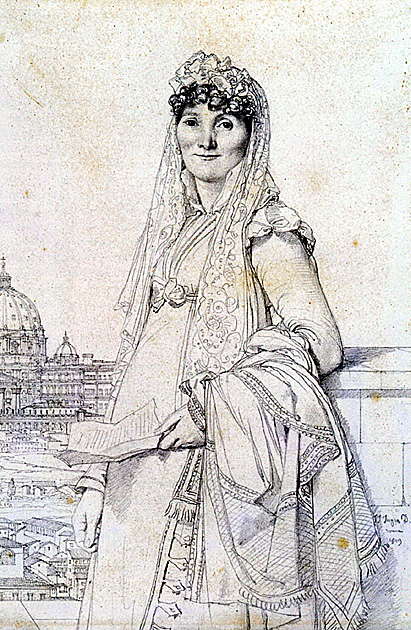
Madame Hippolyte Flandrin born Aimee Caroline Ancelot
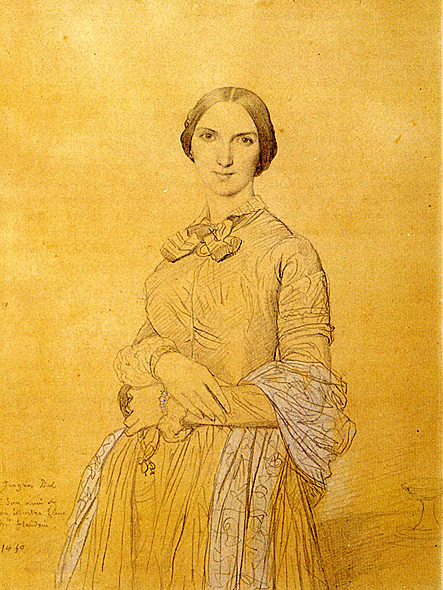
Madame Jacquelles Louis Leblanc born Francoise Poncelle
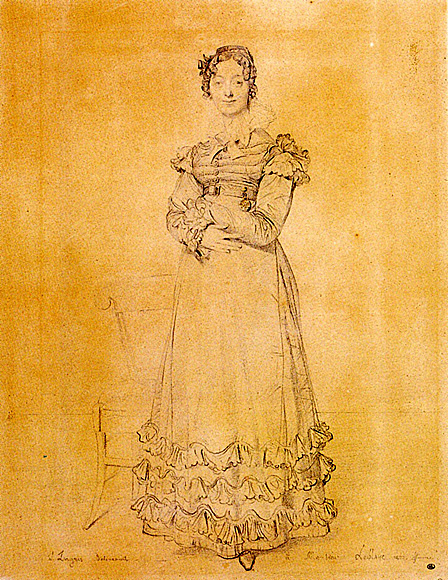
Madame Jacques Louis Leblanc
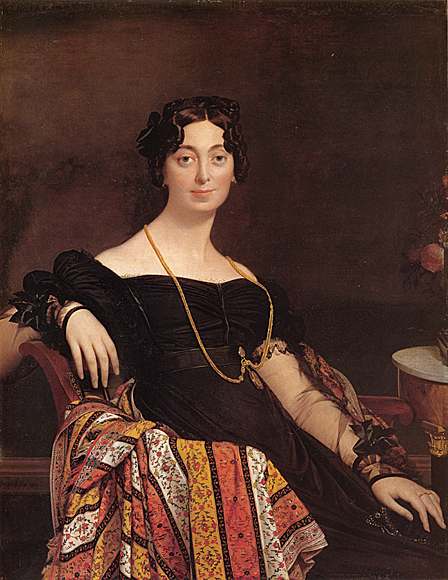
Madame Leblanc (Detail)
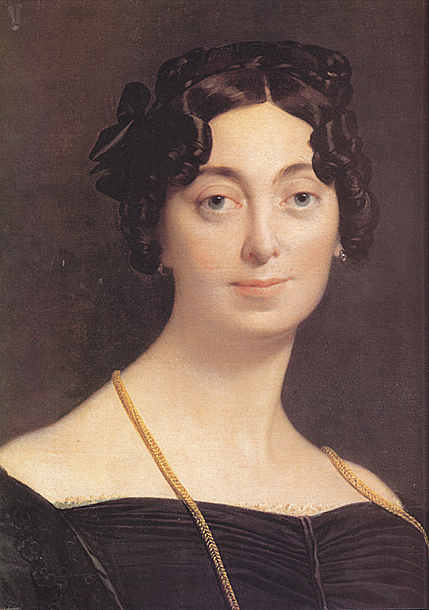
Jacques Louis Leblanc
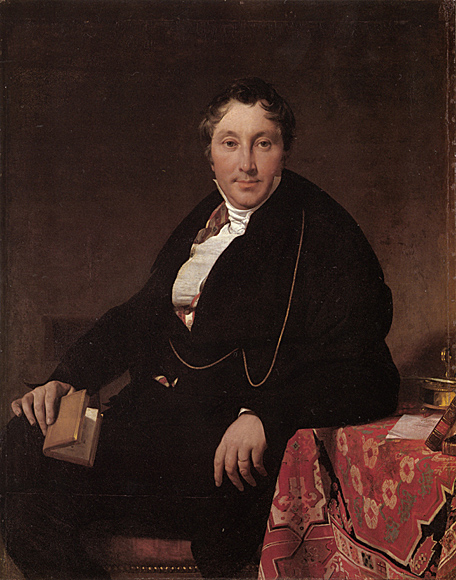
This portrait of Leblanc and that of his wife, Françoise Poncelle Leblanc were painted in 1823, shortly after Ingres met the couple in Florence. Madame Leblanc was the lady-in-waiting to the Grand Duchess of Tuscany, Napoleon's sister Elisa Bacchiochi. Monsieur Leblanc was the Grand Duchess's secretary and the Governor of the Principality of Piombino.
Madame Johann Gotthard Reinhold born Sophie Amalie Dorothea Wilhelmine Ritter
And Her Two Daughters Susette and Marie
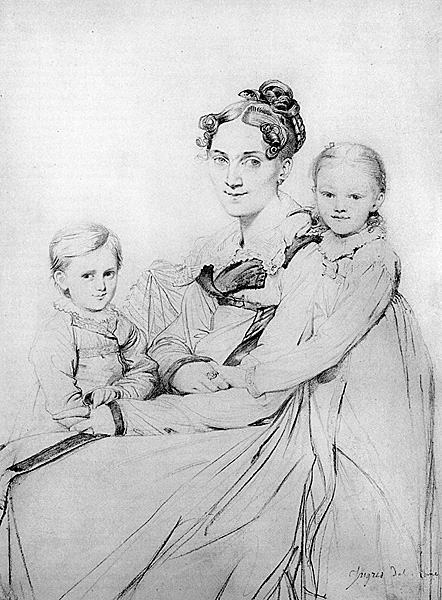
Madame Louis Francois Bertin
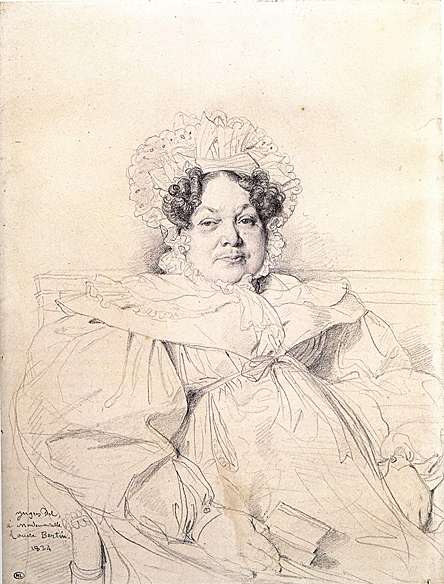
This likeness of Madame Bertin (b. 1772) was intended as a companion to a drawing of her husband that Ingres made two years after the famous oil portrait. Ingres is realistic to the extreme, depicting his obese sitter with her bonnet, curls, and mustache; but he stops short of caricature. The drawing is dedicated to the couple's daughter Louise, a poet and composer of operas.Madame Louis Francois Godinot born Victoire Pauline Thiolliere de L'Isle

Madame Marie Marcotte
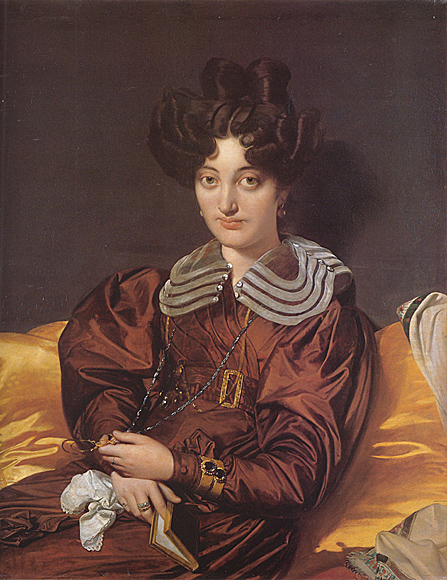
Madame Paul Sigisbert Moitessier
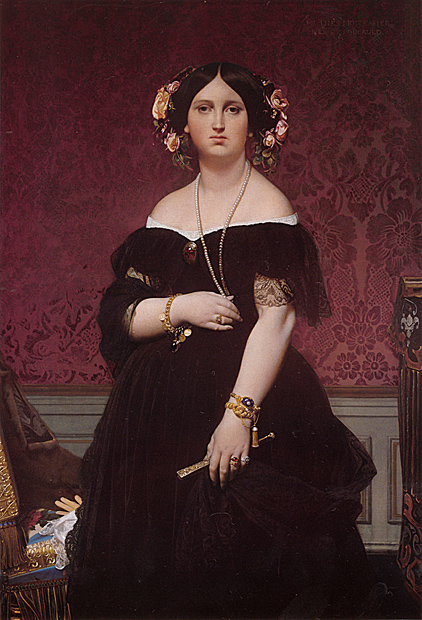
Ingres was so captivated by Madame Moitessier (1821-1897) that he spent twelve years working on two separate portraits of her, one seated and one standing. This standing portrait was begun after, but completed before, the seated portrait; Ingres finished the former in December 1851.
Madame Riviere
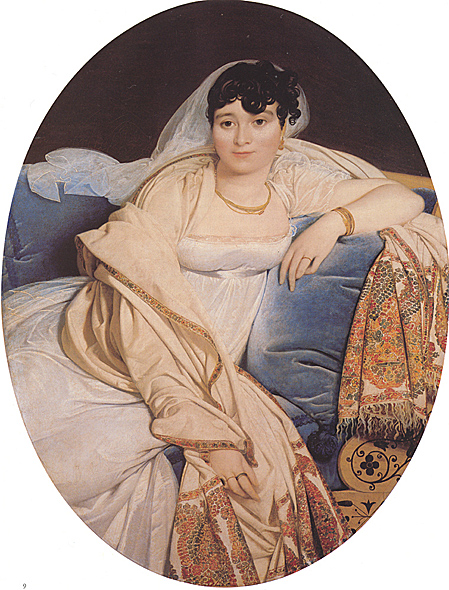
Madame Riviere (Detail)
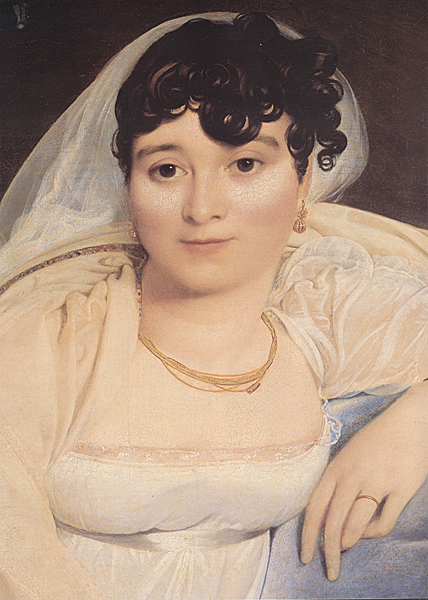
Madame Victor Baltard born Adeline Lequeux and Her Daughter Paule
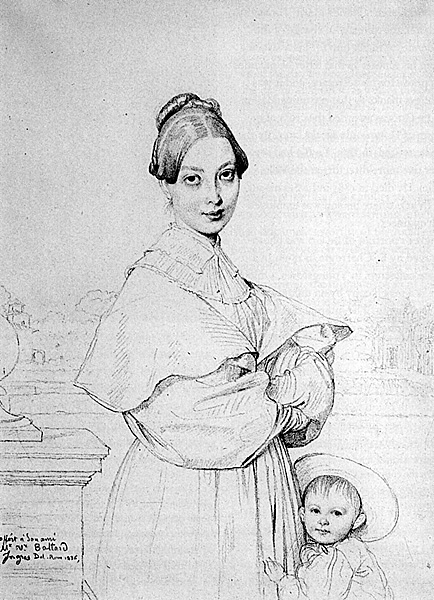
Mademoiselle Cecile Panckoucke
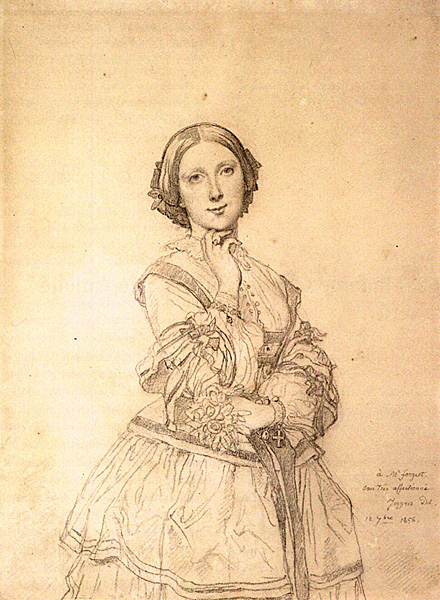
Mademoiselle Henriette Ursule Claire maybe Thevenin and Her Dog Trim
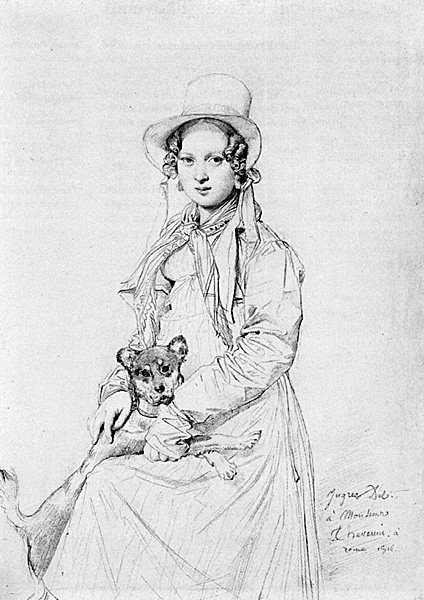
Mademoiselle Jeanne Hayard

Mademoiselle Jeanne Suzanne Catherine Gonin
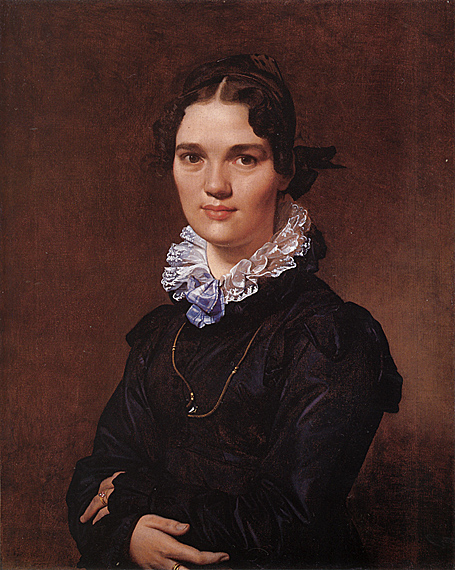
Mademoiselle Mary de Borderieux
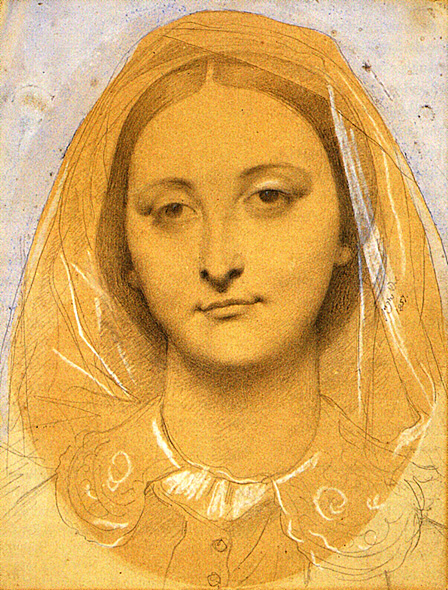
Marcotte d'Argenteuil
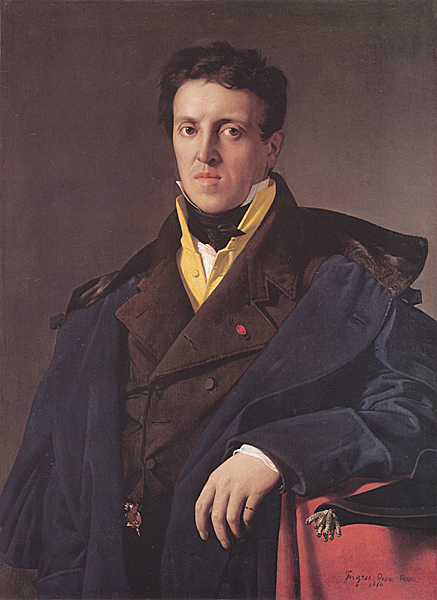
The Portrait of Charles Marcotte Argenteuil, executed in graphite pencil and dated 1811, is a testament to the friendship between Jean-Auguste-Dominique Ingres (Montauban, 1780 - Paris, 1867) and its model. Inspector of Water Affairs and Forestry, Charles Marcotte d'Argenteuil (1773-1864) is sent to Rome at the request of the emperor Napoleon in 1810. Desiring to offer his portrait to his mother remained in Paris, Charles Marcotte d'Argenteuil addresses Ingres which then completes its fourth year of boarding school at the French Academy in Rome. Ingres produces three portraits of Charles, which it is the mid-body to the Vatican. The faithful patron of Ingres also commissioned portraits of various members of his family. Demeurée in his presentation of origin, the work of an exceptional quality, which emerged fully spontaneity of the artist and his keen sense of observation, shows the quintessence of the art of Ingres in the field of drawn portraits.
During his long life, Ingres has drawn a large number portraits, now as famous as those of Holbein or Clouet, preserved for the most part in public collections in France and abroad, but also in private collections. The Portrait of Charles Marcotte Argenteuil enriches and graphic collections of the Louvre Museum in a sheet all the more valuable it will join the portrait drawn by the beautiful sister of Charles, Suzanne-Clarine of Salvaing de Boissieu, wife Marie Marcotte Sainte-Marie, acquired in 1987 by the Louvre, which also owns his portrait painted.
Mario Luigi Carlo Zenobia Salvatore Cherubini
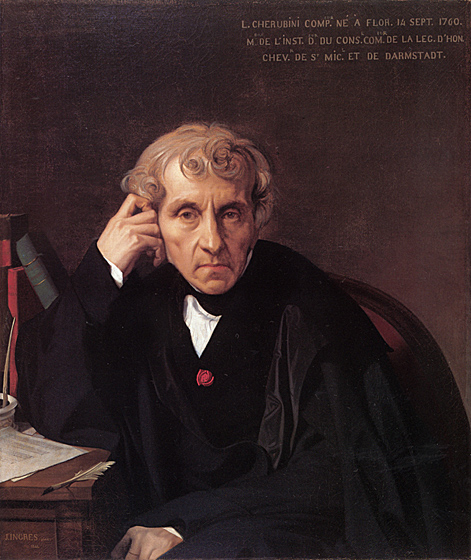
Merry Joseph Blondel
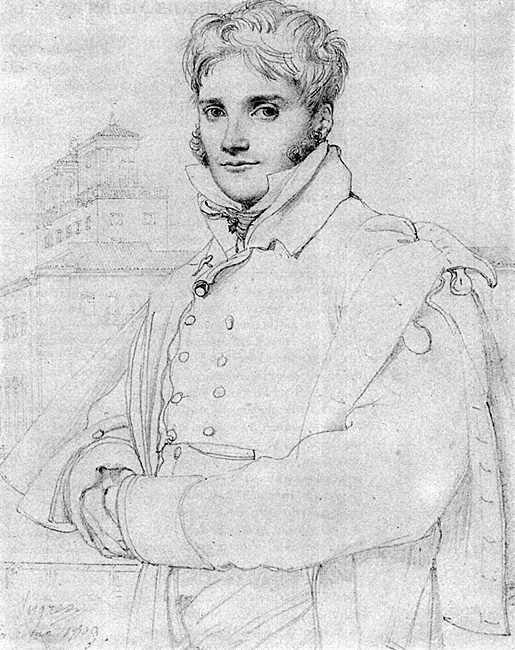
Merry-Joseph Blondel (July 25, 1781 in Paris - June 12, 1853 in Paris) is a french academic painter.
After an initial learning to manufacture porcelain Dihl and Guerhard, where he was a student of Charles Etienne Leguay, he studied painting with Jean-Baptiste Regnault. His Aeneas carrying her father Anchises earned him the Prix de Rome in 1803. He stayed at the Villa Medici in 1809 to 1812, then won at the Salon of 1817 a gold medal for his Death of Louis XII. He then began a career as a decorator: lounge and Diana gallery at Fontainebleau castle, the palace ceiling Brongniart, ceilings from the Louvre Museum, including that of the Apollo Gallery, chamber of the Senate.
Merry-Joseph Blondel was elected a member of the Academy of Fine Arts in 1832, then he was appointed professor at the School of Fine Arts.
Monsignor Gabriel Cortois de Pressigny

Mrs. Charles Badham born Margaret Campbell
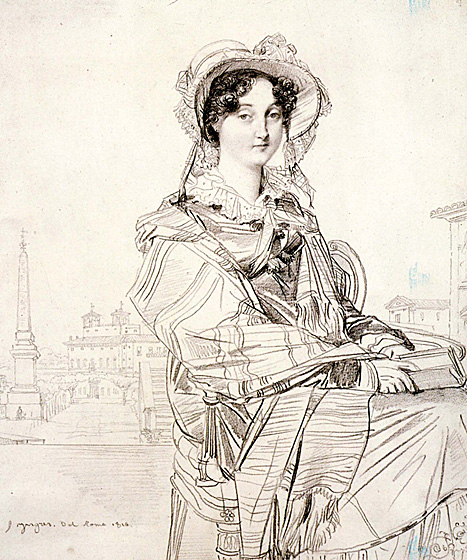
Mrs. Charles Thomas Thruston born Frances Edwards
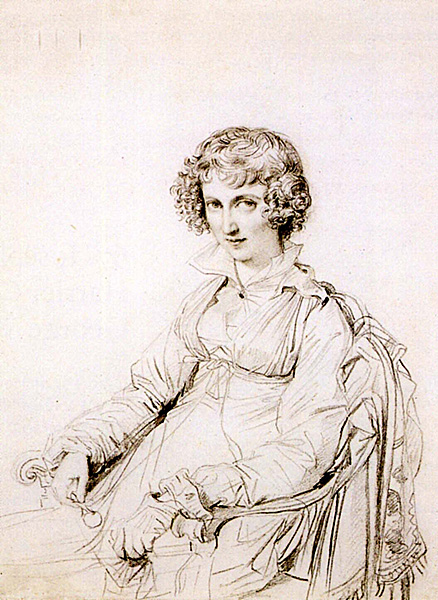
Mrs. John Mackie born Dorothea Sophia de Champs
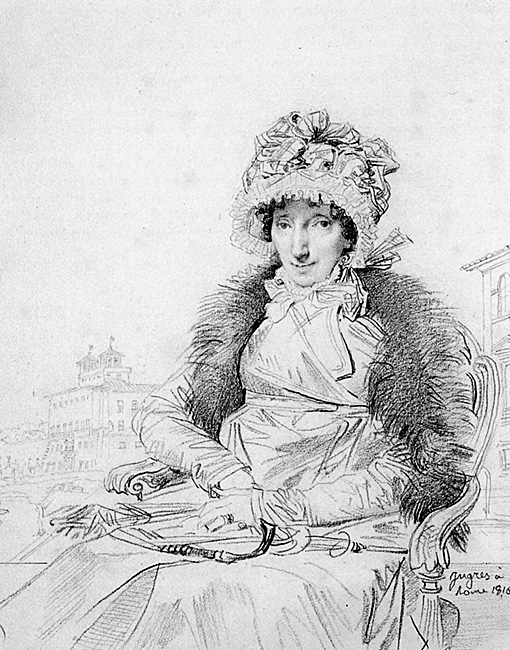
Mrs_Charles_Badham
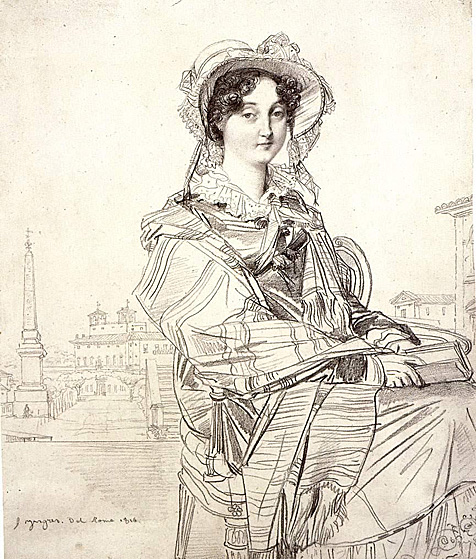
Niccolo Paganini
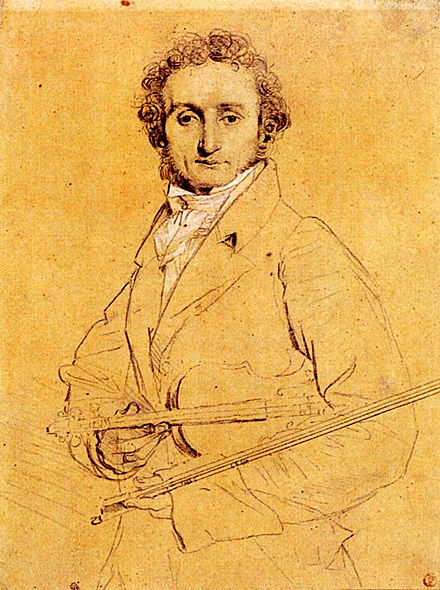
Niccolò Paganini (born Genoa, October 27, 1782, died Nice, May 27, 1840) was an Italian violinist, violist, guitarist, and composer. He was one of the most celebrated violin virtuosi of his time, and left his mark as one of the pillars of modern violin technique. His caprice in A minor, Op. 1 No. 24 is among his best known compositions, and serves as inspiration for other prominent artists from Johannes Brahms to Sergei Rachmaninoff.
Oedipus and the Sphinx
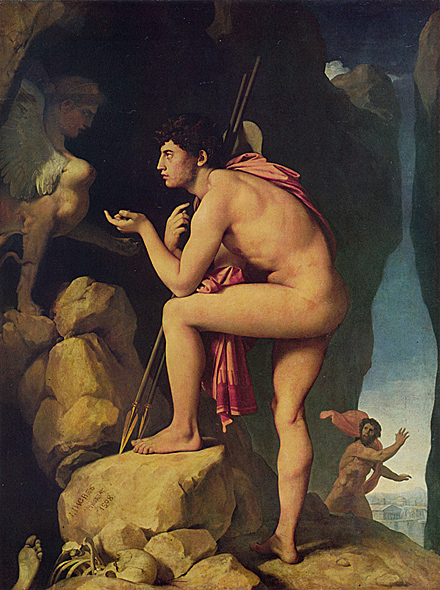
It was said in late lore that Hera or Ares sent the Sphinx from her Ethiopian homeland (the Greeks always remembered the foreign origin of the Sphinx) to Thebes in Greece where, in the writings of Sophocles, Oedipus Tyrannus, she asks all passersby history's most famous riddle: "Which creature in the morning goes on four feet, at noon on two, and in the evening upon three?" She strangled and devoured anyone unable to answer. In another tale of late Greek lore, a Sphinx once blocked the way to Thebes. She would give a riddle: "What walks on four legs in the morning, on two legs at noon, and on three legs in the evening?" Oedipus solved the riddle: answering, Man-who crawls on all fours as a baby, then walks on two feet as an adult, and walks with a cane in old age.
Bested at last, the tale continues, the Sphinx then threw herself from her high rock and died. An alternative version tells that she devoured herself. Thus Oedipus can be recognized as a liminal or "threshold" figure, helping effect the transition between the old religious practices, represented by the death of the Sphinx, and the rise of the new, Olympian deities.
Otto Magnus von Stackelberg and Possibly Jackob Linckhs
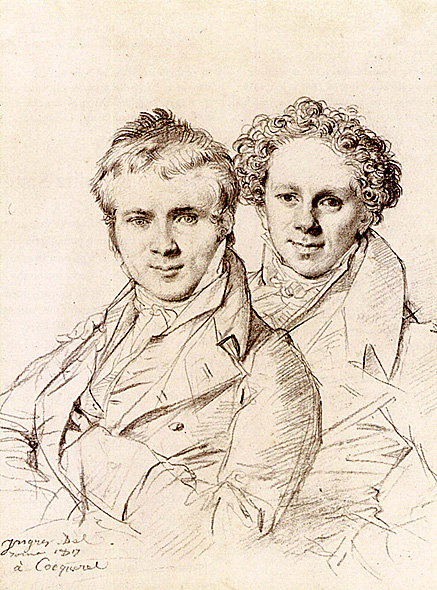
Paolo and Francesca: 1819
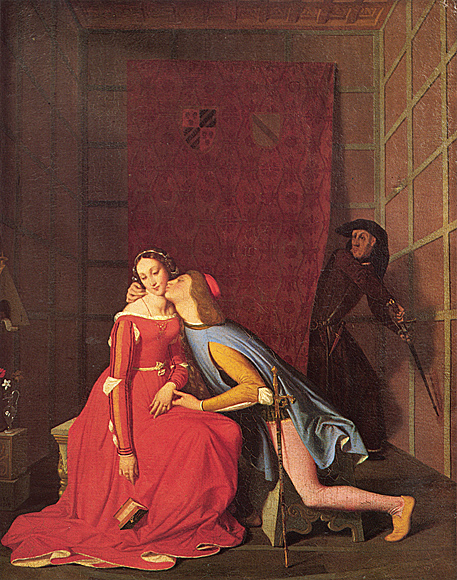
Francesca da Rimini or Francesca da Polenta (1255 - 1285) was the beautiful daughter of Guido da Polenta, lord of Ravenna. She was a historical contemporary of Dante Alighieri, who portrayed her as a character in the Divine Comedy.
Pierre Marie Francois de Sales Baillot
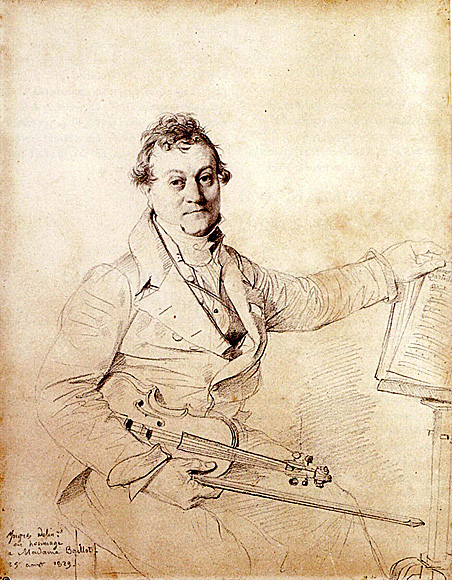
Pierre Marie François de Sales Baillot (October 1, 1771-September 15, 1842) was a French violinist and composer.
Baillot was born in Passy and studied the violin under Giovanni Battista Viotti. He taught violin at the Paris Conservatoire and together with Pierre Rode (also a pupil of Viotti) and Rodolphe Kreutzer wrote the conservatoire's official violin method (published in the early 1800s). Baillot was sole author of the instructional L'art du violon (1834). Baillot's teachings had a profound influence on technical and musical development in an age in which virtuosity was openly encouraged. He was leader of the Paris Opéra, gave solo recitals and was a notable performer of chamber music. He died in Paris in 1842.
Portrait of a Man
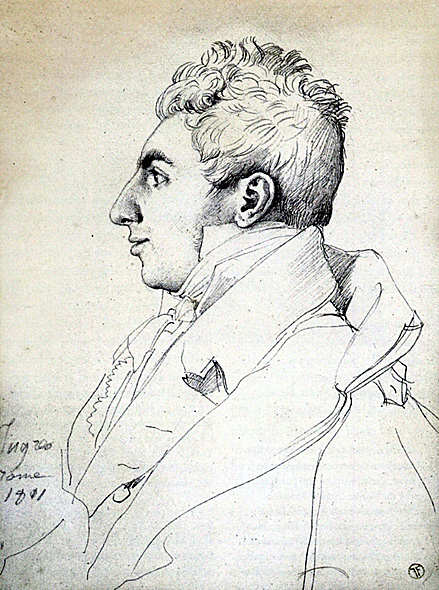
Princess Albert de Broglie

Princess Albert de Broglie (Detail)
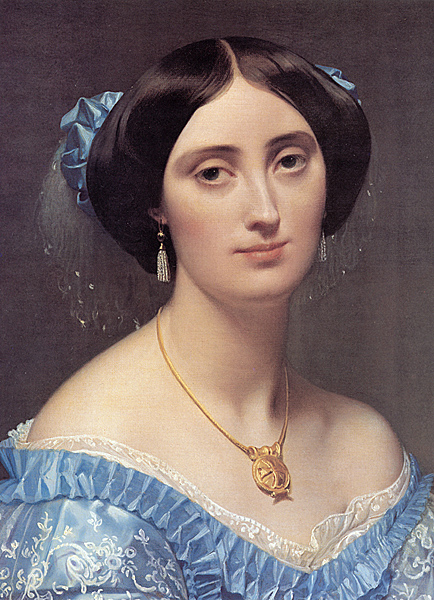
The Fashion of Her Day: Princess Albert de Broglie wears a blue silk gown with delicate lace and ribbon trim. Her hair is covered with a sheer frill trimmed with matching blue ribbon knots. She wears a necklace, tasseled earrings, and bracelets on each wrist.
Raphael and the Fornarina
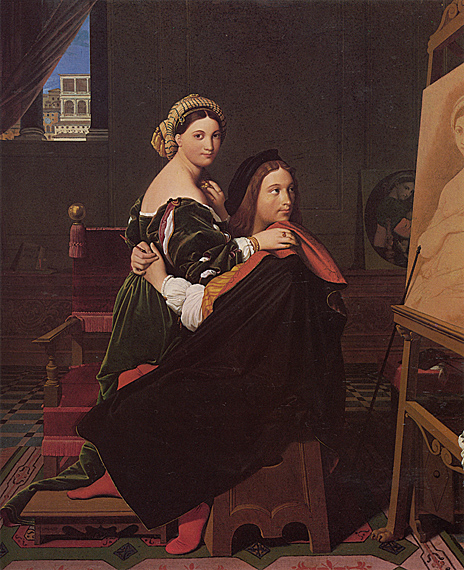
This painting represents Ingre's commentary on Raphael's La Fornarina. We can see two people united in one (like on Leonardo's Virgin and Child with Saint Anne), which look like the same person?!
La Fornarina is very unusual at least in two matters. The position of the sitter is the same as Mona Lisa's - we called it 'naked Mona Lisa'. And the placement of Raphael's signature is very unusual for this time. It is incorporated in the painting as a gravure on a bracelet.
Roger Delivering Angelica
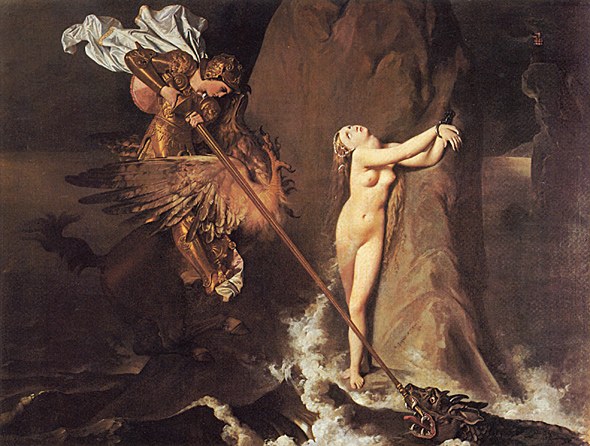
A Hippogriff (also spelled Hippogryph and Hippogryphe) is a legendary creature, supposedly the offspring of a griffin and a mare. Ludovico Ariosto's poem, Orlando furioso (1516) contains an early description (canto IV):
XVIII
No empty fiction wrought by magic lore,
But natural was the steed the wizard pressed;
For him a filly to griffin bore;
Hight hippogryph. In wings and beak and crest,
Formed like his sire, as in the feet before;
But like the mare, his dam, in all the rest.
Such on Riphaean hills, though rarely found,
Are bred, beyond the frozen ocean's bound.
XIX
Drawn by enchantment from his distant lair,
The wizard thought but how to tame the foal;
And, in a month, instructed him to bear
Saddle and bit, and gallop to the goal;
And execute on earth or in mid air,
All shifts of manege, course and caracole;
He with such labour wrought. This only real,
Where all the rest was hollow and ideal.
According to Thomas Bulfinch's Legends of Charlemagne:
"Like a griffin, it has the head of an eagle, claws armed with talons, and wings covered with feathers, the rest of its body being that of a horse. This strange animal is called a Hippogriff."
The reason for its great rarity is that griffins regard horses as prey. It has been suggested this idea was strong enough in medieval times to produce an expression, "to mate griffins with horses", which meant about the same as the modern expression, "When pigs fly". The hippogriff was therefore a symbol of impossibility and love. This was supposedly inspired by Virgil's Ecologues: ... mate Gryphons with mares, and in the coming age shy deer and hounds together come to drink.., which would also be the source for the reputed medieval expression, if indeed it was one.
Among the animal combat themes in Scythian gold adornments may be found griffins attacking horses.
Hippogriff, illustration by Gustave Doré for Orlando furioso.The hippogriff seemed easier to tame than a griffin. In the few medieval legends when this fantastic creature makes an appearance, it is usually the pet of either a knight or a sorcerer. It makes an excellent steed, being able to fly as fast as lightning. The hippogriff is said to be an omnivore, eating either plants or meat.
Another description of the Hippogriff can be found in Arnold Sundgaard's poem, The Hippogriff:
When Mare and Griffin meet and mate
Their offspring share a curious fate.
One half is Horse with hooves and tail,
The rest is Eagle, claws and nail.
As a Horse it likes to graze
In summer meadows doused in haze,
Yet as an Eagle it can fly
Above the clouds where dreams drift by.
With such a Beast I am enthralled,
The Hippogriff this beast is called.
Ingres - Self Portrait
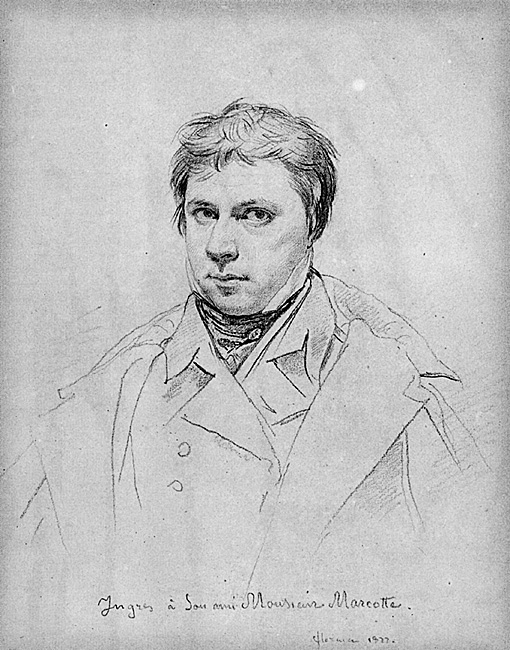
Study for Raphael and the Fornarina
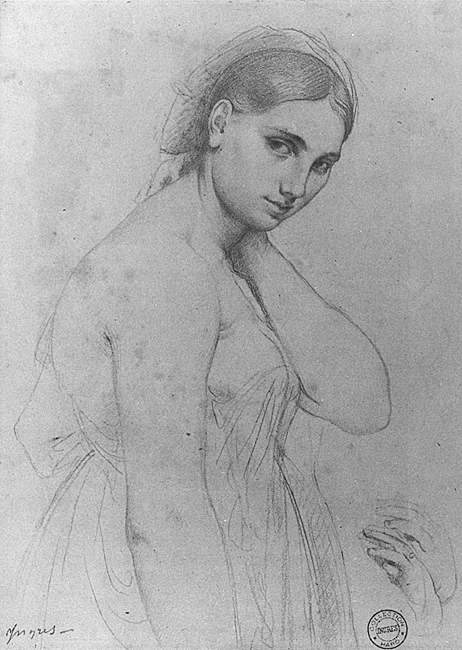
Study for Venus a Paphos
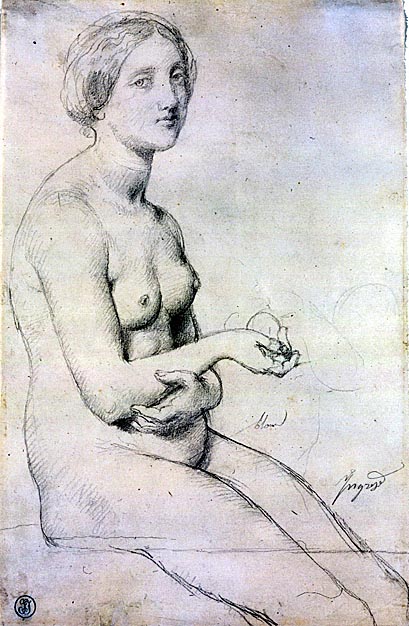
Study for Vicomtesse d'Haussonville born Louise Albertine de Broglie
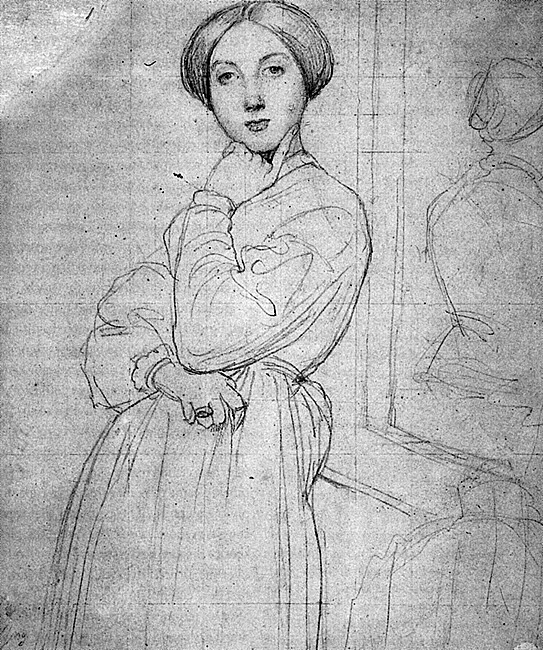
Study for Vicomtesse d'Haussonville born Louise Albertine de Broglie (Detail)
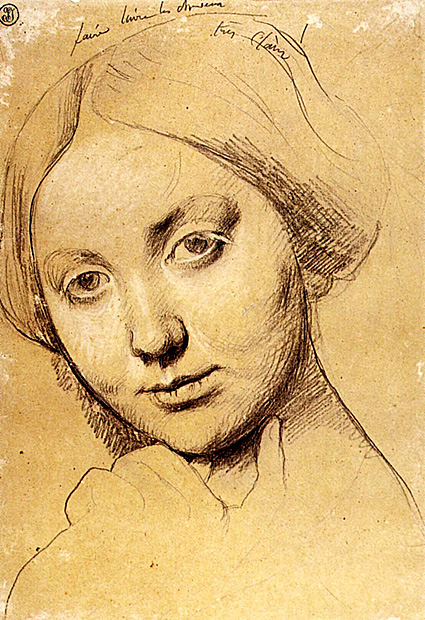
Study of Baronne James de Rothschild born Betty von Rothschild
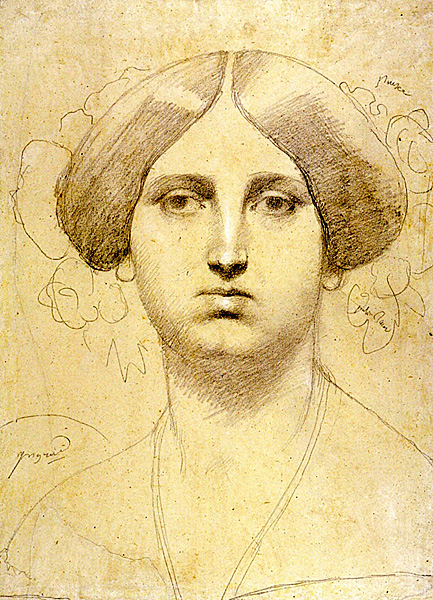
The Alexandre Lethiere Family

The Cosimo Andrea Lazzerini Family
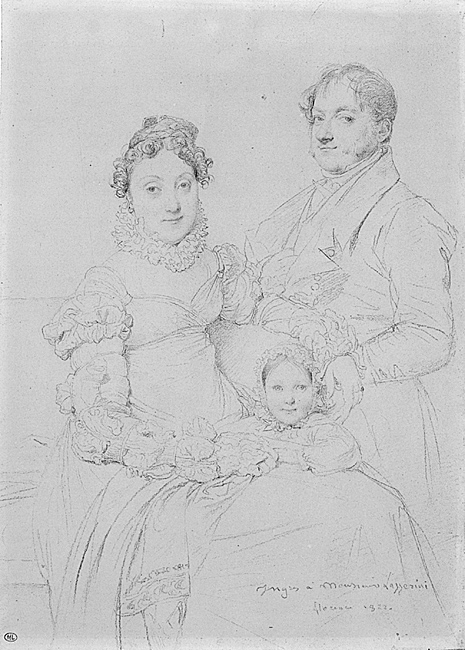
The Kaunitz Sisters
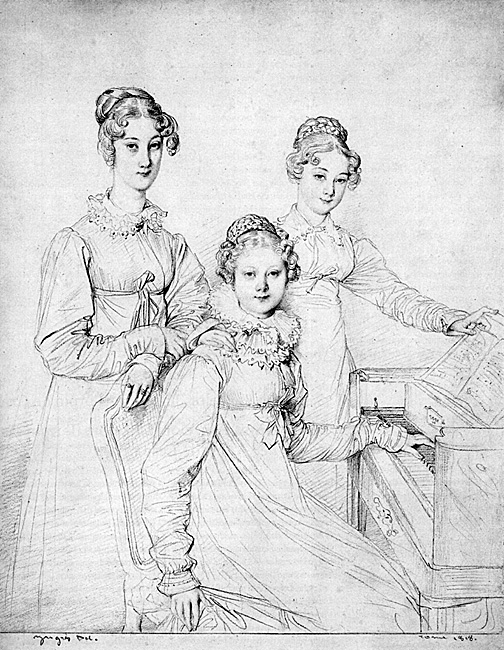
The Reverend Joseph Church
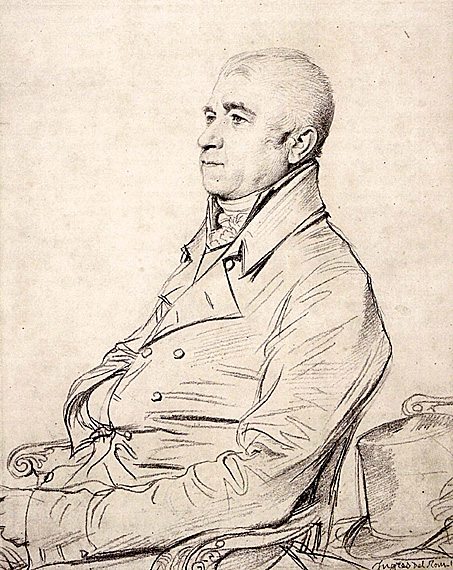
Ursin Jules Vatinelle
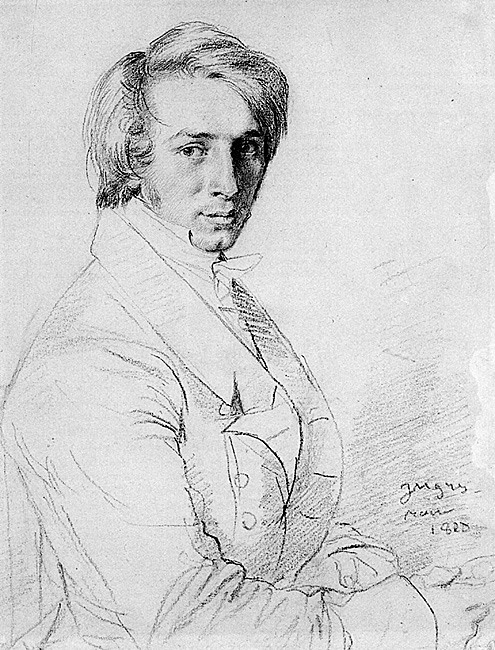
Venus Anadyomene
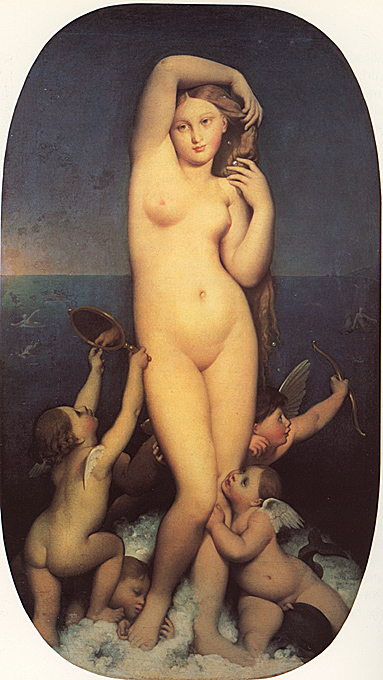
Venus Anadyomene ("Venus Rising From the Sea") was one of the iconic representations of Aphrodite, made famous in a much-admired painting by Apelles, now lost, but described in Pliny's Natural History, with the anecdote that the great Apelles employed Campaspe, a mistress of Alexander the Great, for his model. According to Athenaeus, the idea of Aphrodite Rising from the Sea was inspired by Phryne who during the time of the festivals of the Eleusinia and Poseidonia had no problem swimming nude in the sea.
Vicomtesse Othenin d'Haussonville
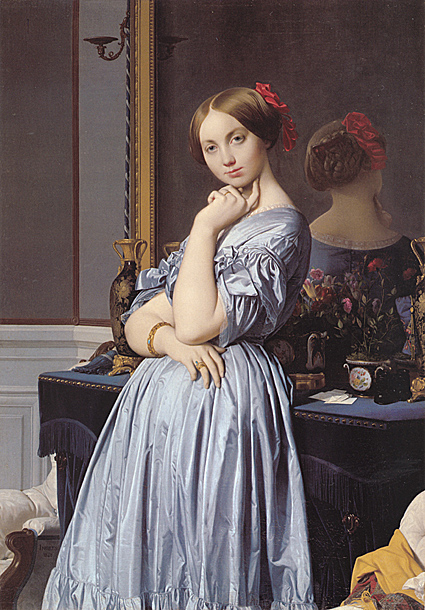
Vicomtesse Othenin d'Haussonville (Detail)
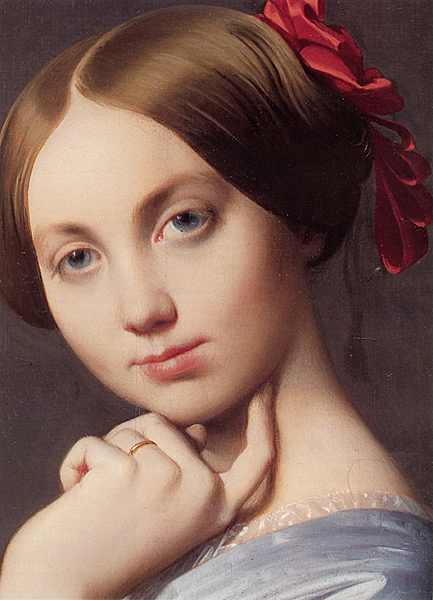
Victor Baltard
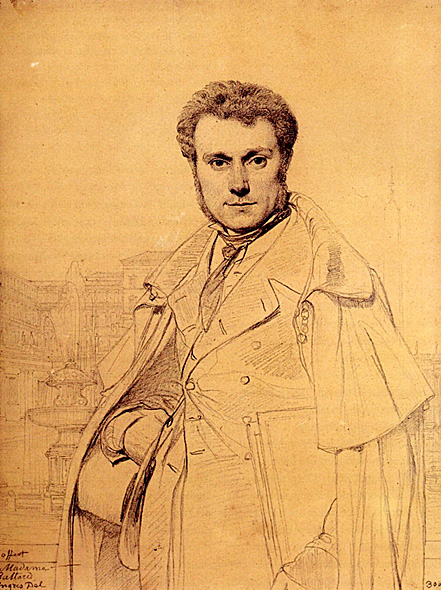
Victor Baltard (June 9, 1805–January 13, 1874), French architect, who was born in Paris, son of architect Louis Baltard.
Until 1833, Baltard studied at the École des Beaux-Arts, where he garnered the Prix de Rome for designing a military school in 1833. He went on to study at the Académie de France in Rome, Italy, from 1834 to 1838 under the direction of Jean Auguste Dominique Ingres. From 1849 on, he was the municipal architect of Paris. In this function, he was responsible for the restoration of several churches, as well as the construction of St. Augustin (1860–1867), in which he united the structural values of stone and steel. His most popular achievement was, however, the building of les Halles, the central market in Paris, during the years 1851 to 1857. In 1972 and 1973, however, these halls were torn down again. A single hall (completed in 1854) was classified as a historical monument and moved to Nogent-sur-Marne in 1971, where it is now known as the Pavilion Baltard.
Victor Baltard also built the slaughter houses and the cattle market of Les Halles de la Villette, as well as the tombs of composer Louis James Alfred Lefébure-Wely at the Cimetière du Père Lachaise and jurist Léon Louis Rostand at the Cimetière de Montmartre. He was largely instrumental in introducing a regular scheme of fresco decoration by modern artists in the churches of Paris, to take the place of the heterogeneous collections of pictures of all kinds with which their walls had been promiscuously decorated.
Victor Dourlen
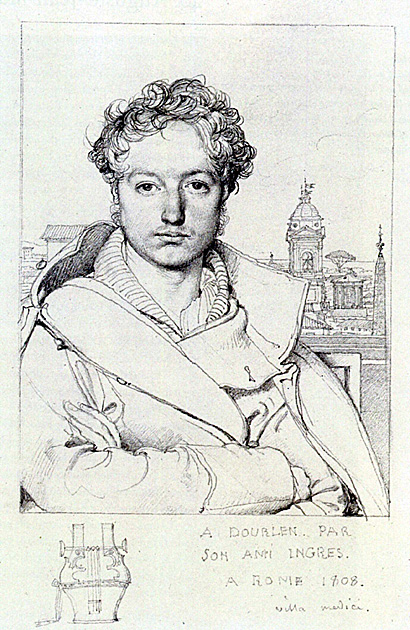
Jean-Louis Provost
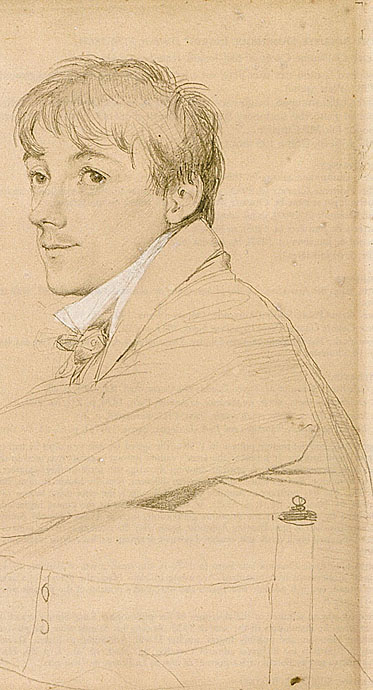
Madame Clement Boulanger

Recent scholarship suggests that this portrait was not originally conceived as a pendant to the portrait of Monsieur Cavé (painted in 1844. Instead, it seems to have been made a decade earlier, when the sitter was married to one of Ingres's pupils, Clement Boulanger . Traces of a curving edge on the surface of the canvas indicate that the portrait had been framed as an oval before Ingres added the dedication.
Madame Cavé was an artist who exhibited regularly at the Salon and the author of popular drawing manuals.
Madame Frederic Reiset
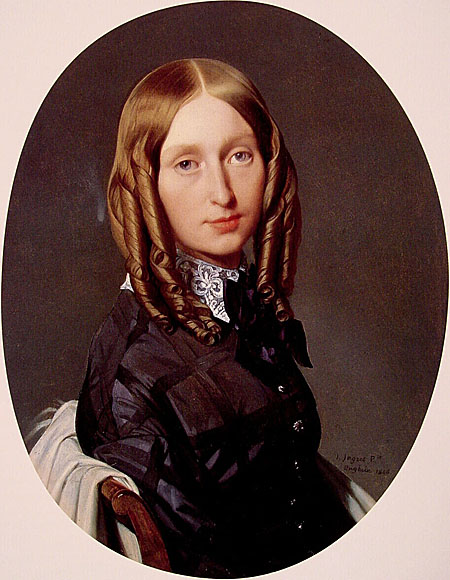
Madame Henri Gonse
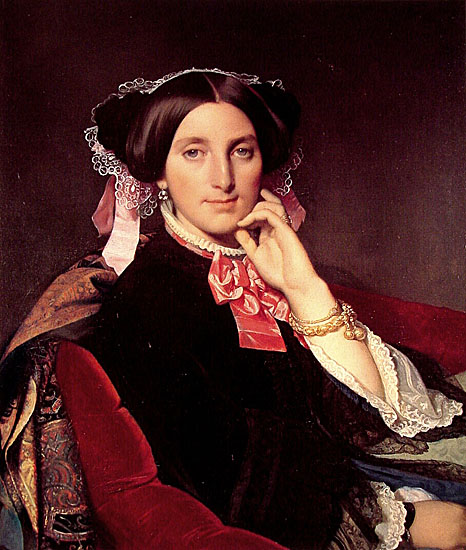
Madame Paul Sigisbert Moitessier
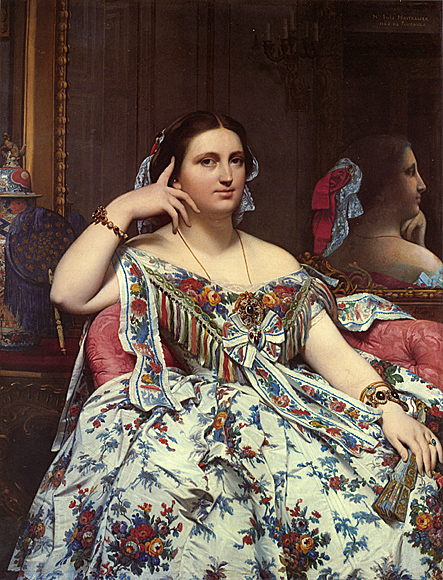
Male Torso
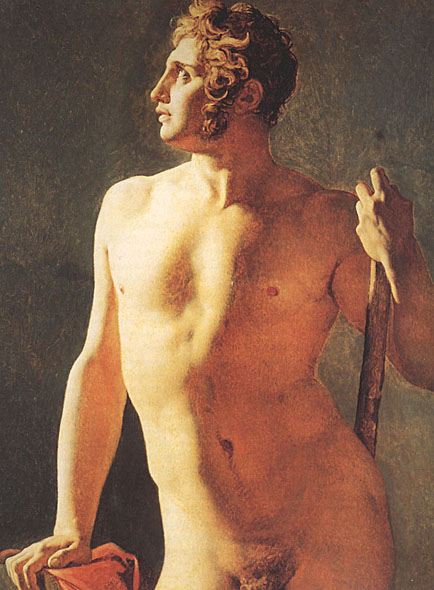
Pierre-Guillame Cazeaux
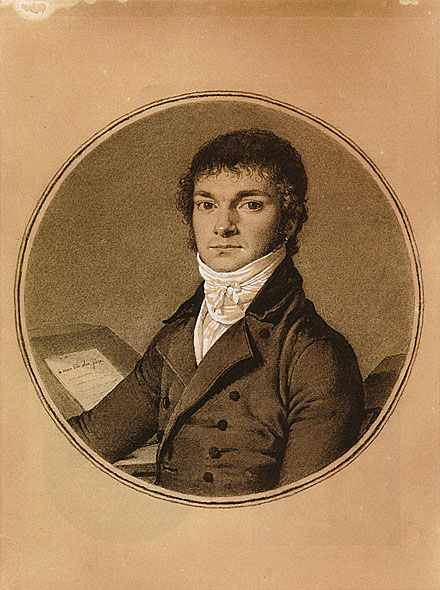
Queen Caroline Murat
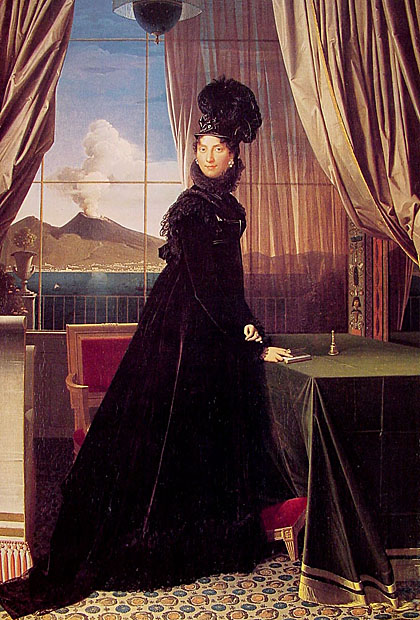
Maria Annunziata Carolina (Marie Annonciade Caroline) Murat (née Bonaparte), Princesse Française, Grand Duchess Consort of Berg and Cleves, Queen Consort of Naples and Sicily, Princess Consort Murat, Comtesse de Lipona (Ajaccio, Corsica, 25 March 1782 - 18 May 1839 in Florence), better known as Caroline Bonaparte, was the seventh surviving child and third surviving daughter of Carlo Buonaparte and Letizia Ramolino.
Caroline was born in Ajaccio, Corsica. She was a younger sister of Joseph Bonaparte, Napoleon I of France, Lucien Bonaparte, Elisa Bonaparte, Louis Bonaparte and Pauline Bonaparte. She was an older sister of Jérôme Bonaparte.
In 1793, Caroline moved with her family to France during the French Revolution. There she fell in love with Joachim Murat, one of her brother's generals, and they married on January 20, 1800. At first Napoleon did not allow them to marry but then his wife Josephine changed his mind. Caroline went to school and was good friends with Hortense, Josephine's daughter and Caroline's brother Louis' wife.
They were parents of four children:
Achille Charles Louis Napoléon Murat, 1st Sovereign Prince of Pontecorvo, 2nd Prince Murat (Paris, January 21, 1801 - Jefferson County, Florida, April 15, 1847), m. Tallahassee, Florida, July 12, 1826 Catherine Daingerfield Willis (near Fredericksburg, Virginia, August 17, 1803 - Tallahassee, Florida, August 6, 1867), daughter of Colonel Byrd C. Willis (August 29, 1781 - 1846) and wife Mary Lewis, without issue.
Princess Marie Letizia Josephine Annonciade Murat (Paris, April 26, 1802 - Bologna, March 12, 1859), m. Venice, October 27, 1823 Guido Taddeo Marchese Pepoli, Conte di Castiglione (Bologna, September 7, 1789 - Bologna, March 2, 1852), and had female issue, an only daughter.
Lucien Charles Joseph Napoléon Murat, 2nd Sovereign Prince of Pontecorvo, 3rd Prince Murat (Milan, May 16, 1803 - Paris, April 10, 1878), m. Bordentown, New Jersey, August 18, 1831 Caroline Georgina Fraser (Charleston, South Carolina, April 13, 1810 - Paris, February 10, 1879), daughter of Thomas Fraser and wife Anne Lauton, and had issue; he was an associate of his first cousin Napoleon III of France.
Princess Louise Julie Caroline Murat (Paris, March 21, 1805 - Ravenna, December 1, 1889), m. Trieste, October 25, 1825 Giulio Conte Rasponi (Ravenna, February 19, 1787 - Florence, July 19, 1876)
Ambitious and power-hungry, she became Grand Duchess of Berg and Cleves on March 15, 1806. She became Queen consort of Naples on August 1, 1808.
The birth of Napoléon II to her namesake brother and his second Empress Consort Marie Louise of Austria, destroyed any hope of her son Napoléon Achille Murat succeeding to her brother. So she allied with Napoléon's rival, Klemens Wenzel von Metternich. When he failed in his attempt to secure the throne for Murat, the latter was executed and Caroline fled to the Austrian Empire. She died in Florence. One of her direct descendants is American actor Rene Auberjonois.
Study for The Golden Age
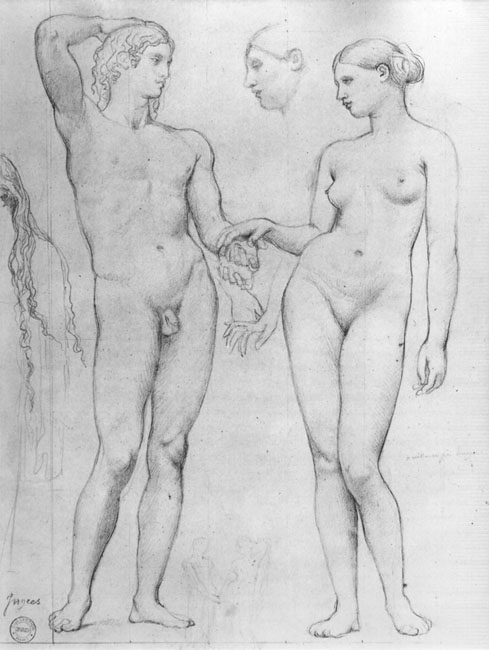
Study for The Martyrdom of St Symphorien
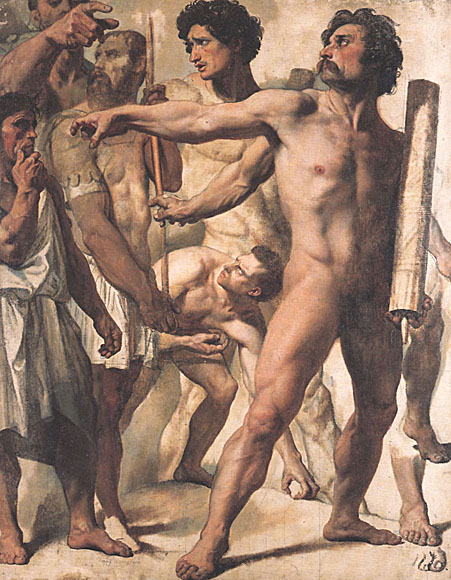
Study for The Martyrdom of St Symphorien
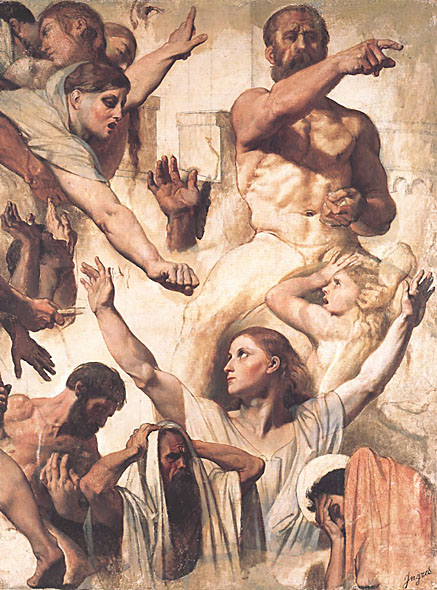
The Apotheosis of Homer
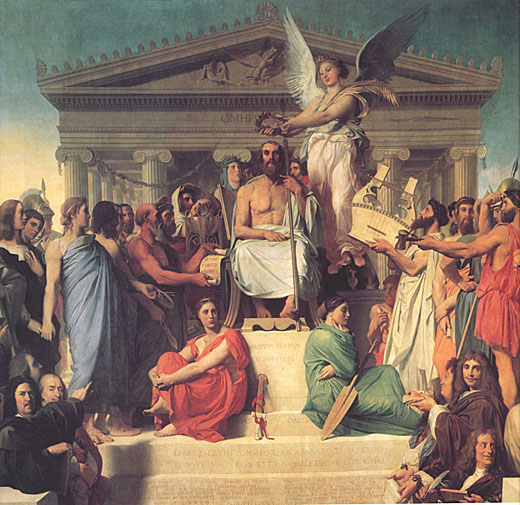
Ingres' Apotheosis of Homer is the first painting that offers a literal elaboration of how the classical tradition was constituted. All of the great artists of history, including those who came after Homer's time, surround Homer in his coronation and come baring gifts. Ingres solved the problem of embodying greatness or un-reachability by constituting the poet as an effect, or rather, as the effects produced by his work. I feel the impact of the painting, is to show that all of the greats from history, from other poets, to playwrights, and composers have Homer to thank for their inspiration and that is why they are honoring him by bringing gifts. Ingres represented Homer as a dead weight at the center of his painting, at once the least embodied and the most embodied of any of the figures. He is the only one seated and facing front, pale and blind, compared with the play of colors, gestures, and glances that animates the surrounding company. Even though the painting is centered around the epic master, he seems alone a dead weight in the center of the painting, who appears pale and blind, while the rest of the painting seems alive with colors and gestures. Homer is shown with his two works, embodied in the people sitting at his feet. His poems, both portrayed as women, are the only women in the painting except for the angel giving Homer his crown; almost seem mad at one another. The Iliad, which is shown with a sword, is pouting, while the Odyssey, shown with an oar, has her head turned the other direction and appears to be angry because her right hand is propped up against face and her left arm is crossed across her body in defiance.
If one looks closely at Homer and studies his figure, one can see that Homer is the only ancient accorded a little eruption of illusionism, in the form of the foot that sticks out in the middle of the composition, one of the painting's rare passages of projection into space. Also notice the contrasting colors that are present in the painting. Significant figures, such as Virgil, Raphael, Herodotus, Pindar, Longinus, and of course Homer are adorned in white.
The title of the painting, The Apotheosis of Homer, puts the objectification of Homer into perspective. The meaning of the word apotheosis is exaltation to divine rank or stature. The arrangement of Homer on a pedestal being crowned like a king for his greatness and being lavished with gifts, resembles the format of an altarpiece, with its godhead and descending tiers of the elect. Ingres made the analogy explicit through the Greek inscriptions in his painting: the lintel of the temple above Homer is inscribed, To Homer God, while the text chiseled into the step below the Iliad and the Odyssey reads. If Homer is a god, that one honors him among gods; if he is not a god, that he be regarded as one. Through all these means Ingres accomplishes the idea that Homer is a god.
The Bather
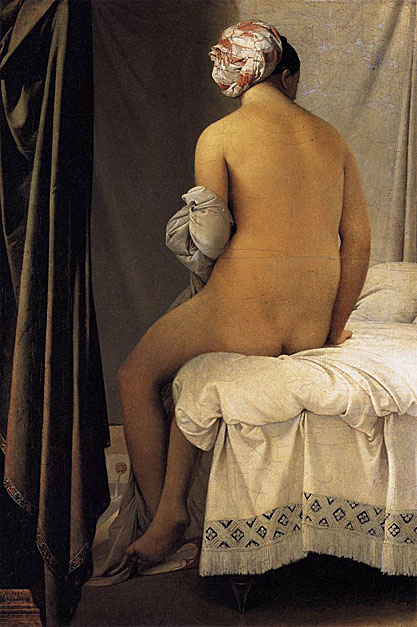
The Betrothal of Raphael
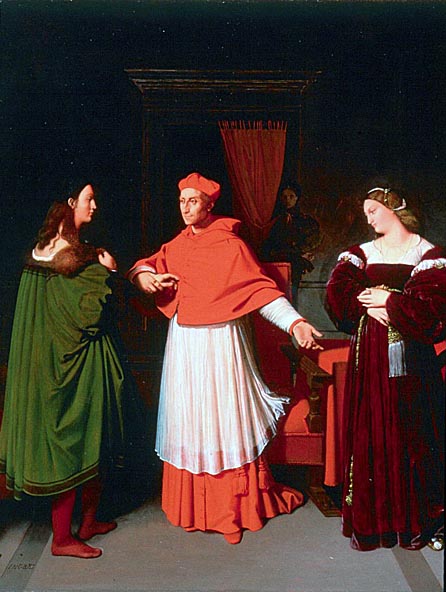
The Dream of Ossian: 1813
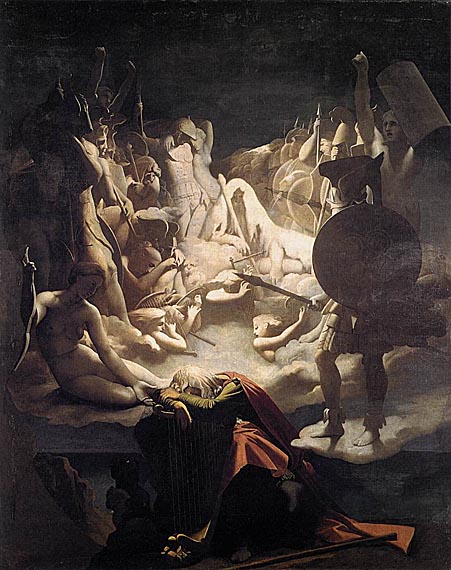
Ossian is the narrator, and supposed author, of a cycle of poems which the Scottish poet James Macpherson claimed to have translated from ancient sources in the Scots Gaelic. He is based on Oisín, son of Finn or Fionn mac Cumhaill, a character from Irish mythology. The furore over the authenticity of the poems continued into the 20th century.
The Entry of the Future Charles V into Paris in 1358

1328
The Valois dynasty (1328-1589) gets off to a rough start with King Philippe VI (reigns 1328-1350), a war-monger with eyes focused on the English. Nicknamed "the Fortunate," he's married to Jeanne "the lame." She may have a game leg but wears the pants, especially when Philip is making war, and produces 7 stout children.
1358
Uprising of feisty Etienne Marcel, mayor of Paris and provost of merchants. Marcel gets on the bad side of John the Good, tries to oust Charles, also Good, and replace him with Charles the Bad (upstart King of Navarre). The trend-setting first of many popular Paris revolts. 500 years later a street, station and statue will honor Marcel's name.
1364
Charles V (reigns 1364-1380) is dubbed "the wise," restores law and order to Paris and unwisely builds the Bastille and walls marking what's now les Grands Boulevards and l'Arsenal, later the quintessential symbols of oppression. He also unwisely practices favoritism, but cleverly defeats the evil Edward of Woodstock, aka the Black Prince.
The Sword of Henry IV: 1832
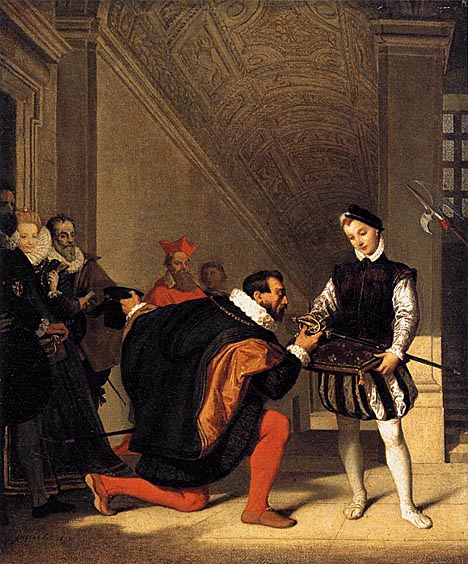
The Vow of Louis XIII: 1824
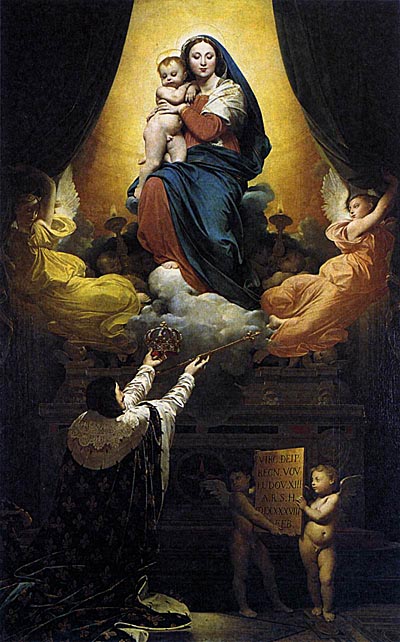
Born at the Château de Fontainebleau, Louis XIII was the eldest child of Henry IV of France (1589-1610) and Marie de' Medici. His father was the first Bourbon King of France, having succeeded his ninth cousin, Henry III of France (1574-89), in application of the Salic law. Louis XIII's paternal grandparents were Antoine de Bourbon, Duke of Vendome and Jeanne d'Albret, Queen of Navarre; his maternal grandparents were Francesco I de' Medici, Grand Duke of Tuscany and Johanna, archduchess of Austria.

Turkish Bath
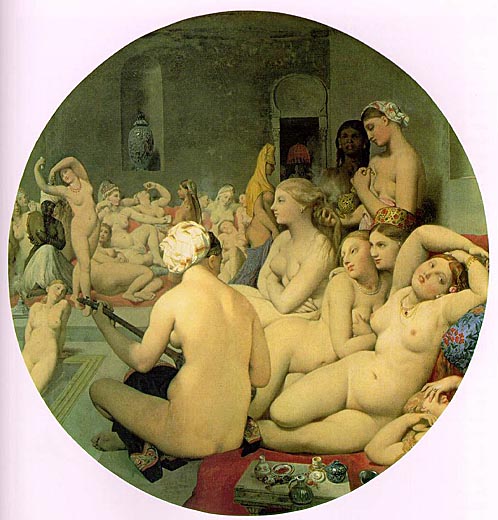
Virgin of the Adoption
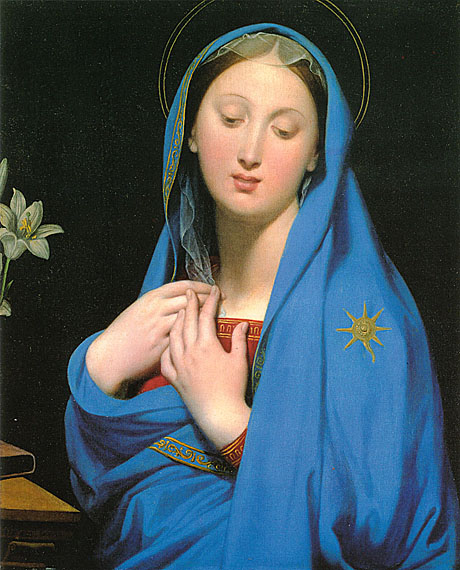
Source: Art Renewal Center
This page is the work of Senex Magister
Return to Pagina Artis
Return to Bruce and Bobbie's Main Page.
 Viatores
Viatores






















































































































































